

Inspiring Ink: Expert Tips on How to Teach Creative Writing
The world of creative writing is as vast as it is rewarding. It’s a form of expression that allows the writer to explore different worlds, characters, and narratives – all within the power of their pen.
But what exactly is creative writing and why is it important? Let’s explore the value of creative writing and how to inspire young (or old!) minds to embark on the curious and exciting journey of writing creatively – it’s easier than you think!
What is Creative Writing?
Creative writing, in its simplest form, is writing that goes beyond the bounds of normal professional, journalistic, academic, or technical forms of literature.
It’s characterized by its emphasis on:
- narrative craft
- character development
- the use of literary devices
From poetry to plays, scripts to sonnets, creative writing covers a wide range of genres . It’s about painting pictures with words, invoking emotions, and bringing ideas to life . It’s about crafting stories that are compelling, engaging, and thought-provoking.
Whether you’re penning a novel or jotting down a journal entry, creative writing encourages you to unleash your imagination and express your thoughts in a unique, artistic way. For a deeper dive into the realm of creative writing, you can visit our article on what is creative writing .
Benefits of Developing Creative Writing Skills
The benefits of creative writing extend beyond the page.
It’s not just about creating captivating stories or crafting beautiful prose. The skills developed through creative writing are invaluable in many aspects of life and work.
1. Creative writing fosters creativity and imagination.
It encourages you to think outside the box, broaden your perspective, and explore new ideas. It also enhances your ability to communicate effectively, as it involves conveying thoughts, emotions, and narratives in a clear and compelling manner.
2. Creative writing aids in improving critical thinking skills.
It prompts you to analyze characters, plotlines, and themes, and make connections between different ideas. This process activates different parts of the mind, drawing on personal experiences, the imagination, logical plot development, and emotional intelligence.
3. Creative writing is also a valuable tool for self-expression and personal growth.
It allows you to explore your feelings, experiences, and observations, providing an outlet for self-reflection and introspection. By both reading and writing about different characters in different situations, readers develop empathy in a gentle but effective way.
4. Creative writing skills can open up a host of career opportunities.
From authors and editors to content creators and copywriters, the demand for creative writers is vast and varied. You can learn more about potential career paths in our article on creative writing jobs and what you can do with a creative writing degree .
In essence, creative writing is more than just an art—it’s a skill, a craft, and a powerful tool for communication and self-expression. Whether you’re teaching creative writing or learning it, understanding its value is the first step towards mastering the art.
The 3 Roles of a Creative Writing Teacher
Amongst the many facets of a creative writing teacher’s role, three vital aspects stand out: inspiring creativity , nurturing talent , and providing constructive criticism . These elements play a significant role in shaping budding writers and fostering their passion for the craft.
1. Inspiring Creativity
The primary function of a creative writing teacher is to inspire creativity.
They must foster an environment that encourages students to think outside the box and explore new possibilities . This includes presenting students with creative writing prompts that challenge their thinking, promoting lively discussions around various topics, and providing opportunities for students to engage in creative writing activities for kids .
Teachers should also expose students to a range of literary genres , styles, and techniques to broaden their understanding and appreciation of the craft. This exposure not only enhances their knowledge but also stimulates their creativity, encouraging them to experiment with different writing styles .
2. Nurturing Talent
Nurturing talent involves recognizing the unique abilities of each student and providing the necessary support and guidance to help them develop these skills. A creative writing teacher needs to identify the strengths and weaknesses of each student and tailor their approach accordingly.
This means:
- offering personalized feedback
- setting realistic yet challenging goals
- providing opportunities for students to showcase their work
Encouraging students to participate in writing competitions or to publish their work can give them a confidence boost and motivate them to improve. Furthermore, teachers should educate students about various creative writing jobs and what you can do with a creative writing degree . This knowledge can inspire students to pursue their passion for writing and explore career opportunities in the field.
3. Providing Constructive Criticism
Providing constructive criticism is a critical aspect of teaching creative writing. It involves assessing students’ work objectively and providing feedback that helps them improve .
Teachers should:
- highlight the strengths of the work
- address the areas that need improvement
- suggest ways to make the piece better
Constructive criticism should be specific, actionable, and encouraging . It’s important to remember that the goal is to help the student improve, not to discourage them. Therefore, teachers need to communicate their feedback in a respectful and supportive manner.
In essence, a teacher’s role in teaching creative writing extends beyond mere instruction. They are mentors who inspire, nurture, and shape the minds of budding writers. By fostering a supportive and stimulating environment, they can help students unlock their creative potential and develop a lifelong love for writing.
3 Techniques for Teaching Creative Writing
When it comes to understanding how to teach creative writing, there are several effective techniques that can help inspire students and foster their writing skills.
1. Encouraging Free Writing Exercises
Free writing is a technique that encourages students to write continuously for a set amount of time without worrying about grammar, punctuation, or topic. This type of exercise can help unleash creativity, as it allows students to freely express their thoughts and ideas without judgment or constraint.
As a teacher, you can set a specific theme or provide creative writing prompts to guide the writing session. Alternatively, you can allow students to write about any topic that comes to mind. The key is to create an environment that encourages creative exploration and expression.
2. Exploring Different Genres
Another effective technique is to expose students to a wide range of writing genres. This can include fiction, non-fiction, poetry, drama, fantasy, mystery, and more. By exploring different genres, students can discover their unique writing styles and interests. This variety also offers the chance to expand their writing skills and apply them to various writing formats.
To facilitate this exploration, you can assign writing projects in different genres, conduct genre-specific writing workshops, or invite guest speakers who specialize in different genres. You can also encourage students to critically analyze how different authors approach their work.
3. Analyzing Published Works
Analyzing published works is a powerful way to teach creative writing. This technique allows students to learn from established authors by studying their:
- writing styles
- narrative structures
- use of language.
It also provides a practical context for understanding writing concepts and techniques.
As a teacher, you can select diverse pieces of literature for analysis , ranging from classic novels to contemporary short stories. Encourage students to identify elements they admire in these works and discuss how they can incorporate similar techniques into their own writing.
These techniques for teaching creative writing are effective ways to inspire creativity, encourage self-expression, and develop writing skills. As a teacher, your role is crucial in guiding students through their creative journey and helping them realize their potential as writers.
Creative Writing Workshops and Exercises
One effective method on how to teach creative writing is through the use of targeted workshops and exercises. These interactive sessions can stimulate creativity, foster character development , and help in understanding story structures .
Idea Generation Workshops
Idea generation is a crucial aspect of creative writing. It is the starting point that provides a springboard for writers to explore and develop their narratives. Idea generation workshops can be an interactive and fun way to help writers come up with fresh ideas.
Workshops can include brainstorming sessions , where writers are encouraged to think freely and note down all ideas, no matter how unconventional they may seem. Another method is the use of writing prompts , which can serve as a creative spark.
A prompt could be:
- even an image
Editor’s Note : Encourage children to create a big scribble on a scrap piece of paper and then look for an image in it (like looking for pictures in the clouds). This can be a great creative writing prompt and students will love sharing their writing with each other! Expect lots of giggles and fun!
Character Development Exercises
Characters are the heart of any story. They drive the narrative and engage the readers. Character development exercises can help writers create well-rounded and relatable characters.
Such exercises can include character questionnaires , where writers answer a series of questions about their characters to gain a deeper understanding of their personalities, backgrounds, and motivations. Role-playing activities can also be useful, allowing writers to step into their characters’ shoes and explore their reactions in different scenarios.
Story Structure Workshops
Understanding story structure is vital for creating a compelling narrative. Story structure workshops can guide writers on how to effectively structure their stories to engage readers from start to finish .
These workshops can cover essential elements of story structures like:
- rising action
- falling action
In addition to understanding the basics, writers should be encouraged to experiment with different story structures to find what works best for their narrative style. An understanding of story structure can also help in analyzing and learning from published works .
Providing writers with the right tools and techniques, through workshops and exercises, can significantly improve their creative writing skills. It’s important to remember that creativity flourishes with practice and patience .
As a teacher, nurturing this process is one of the most rewarding aspects of teaching creative writing. For more insights and tips on teaching creative writing, continue exploring our articles on creative writing .
Tips to Enhance Creative Writing Skills
The process of teaching creative writing is as much about honing one’s own skills as it is about imparting knowledge to others. Here are some key strategies that can help in enhancing your creative writing abilities and make your teaching methods more effective.
Regular Practice
Like any other skill, creative writing requires regular practice . Foster the habit of writing daily, even if it’s just a few lines. This will help you stay in touch with your creative side and continually improve your writing skills. Encourage your students to do the same.
Introduce them to various creative writing prompts to stimulate their imagination and make their writing practice more engaging.
Reading Widely
Reading is an essential part of becoming a better writer. By reading widely, you expose yourself to a variety of styles, tones, and genres . This not only broadens your literary horizons but also provides a wealth of ideas for your own writing.
Encourage your students to read extensively as well. Analyzing and discussing different works can be an excellent learning exercise and can spark creative ideas .
Exploring Various Writing Styles
The beauty of creative writing lies in its diversity. From poetic verses to gripping narratives, there’s a wide range of styles to explore. Encourage your students to try their hand at different forms of writing. This not only enhances their versatility but also helps them discover their unique voice as a writer.
To help them get started, you can introduce a variety of creative writing activities for kids . These tasks can be tailored to suit different age groups and proficiency levels. Remember, the goal is to foster a love for writing, so keep the activities fun and engaging .
Have Fun Teaching Creative Writing!
Enhancing creative writing skills is a continuous journey. It requires persistence, curiosity, and a willingness to step out of your comfort zone. As a teacher, your role is to guide your students on this journey, providing them with the tools and encouragement they need to flourish as writers – and most of all – enjoy the process!
For more insights on creative writing, be sure to explore our articles on what is creative writing and creative writing jobs and what you can do with a creative writing degree .
Brooks Manley

Creative Primer is a resource on all things journaling, creativity, and productivity. We’ll help you produce better ideas, get more done, and live a more effective life.
My name is Brooks. I do a ton of journaling, like to think I’m a creative (jury’s out), and spend a lot of time thinking about productivity. I hope these resources and product recommendations serve you well. Reach out if you ever want to chat or let me know about a journal I need to check out!
Here’s my favorite journal for 2024:

Gratitude Journal Prompts Mindfulness Journal Prompts Journal Prompts for Anxiety Reflective Journal Prompts Healing Journal Prompts Cognitive Behavioral Therapy Journal Prompts Mental Health Journal Prompts ASMR Journal Prompts Manifestation Journal Prompts Self-Care Journal Prompts Morning Journal Prompts Evening Journal Prompts Self-Improvement Journal Prompts Creative Writing Journal Prompts Dream Journal Prompts Relationship Journal Prompts "What If" Journal Prompts New Year Journal Prompts Shadow Work Journal Prompts Journal Prompts for Overcoming Fear Journal Prompts for Dealing with Loss Journal Prompts for Discerning and Decision Making Travel Journal Prompts Fun Journal Prompts
Enriching Creative Writing Activities for Kids
You may also like, how to get started journaling: the complete beginner’s guide.
A Guide to Shadow Work Journaling
Stream of consciousness journaling: a beginner’s guide, leave a reply cancel reply.
Save my name, email, and website in this browser for the next time I comment.
- Productivity
- Favorite Journals
- International edition
- Australia edition
- Europe edition

How to teach ... creative writing
Summer is the perfect time of year for a spot of creative writing. Inspire young imaginations to put pen to paper with our lesson plans and ideas
From birds chirping aloft the trees to sapphire blue lakes sparkling in the sun, the sights and sounds of summer make it the perfect time of year for a spot of creative writing. Getting students to put pen to paper is a good way to spark their imaginations, develop reading and writing skills, and teach about empathy.
To help you and your class get inventive, this week’s how to teach brings you a selection of ideas and resources to inspire the creativity of young wordsmiths.
Primary students
Author Nick Hesketh recommends that before children start writing, you should discuss what makes a good story. He shares this and other advice in his creative writing video series for the Scottish Book Trust . Get students thinking with these “badly written” exemplars , which provide a handy baseline to work from.
Next, capture young imaginations by getting students to think about the story they want to tell. Where is it set? At what time of day? What is the weather like? What can you hear, see, smell or feel? This worksheet by Creative Writing Now will help students get to know their main character, while this plot questionnaire will encourage them think about what is going to happen. Then get your class penning their masterpieces, writing just a few sentences to begin with. Stress that they shouldn’t worry about spelling, instead, just put a wavy line under any words they are unsure of. There are examples of well thought-out sentences here .
Creative writing should be fun, and playing games is good way to help students develop story ideas. Try an alternative word association game in which you think of words that are at odds with each other (such as “boat” and “rock”) instead of words that are connected (such as “boat” and “water”). The aim is to show that good story ideas often involve some sort of tension. We also have instructions for a fun game called The Invisible Book , which involves students coming up with the first three sentences of a story on the spot, which helps them find their writer’s voice.
If ideas aren’t flowing, kickstart things by stepping outside of the classroom and into the playground as suggested in this resource by WordSpace . Give students unusual things to write on, such as the back of an envelope, a leaf, or a rough piece of wallpaper. Or challenge them to write a short story in just 50 words.
A quick way to conjure up story ideas is through pictures. Use prompts such as this image of two boys sitting on the wing of an aeroplane or this one of a dinosaur in the garden , which can work really well. Another tip from writer and teacher Heather Wright is to ask students to start several stories then choose the one they want to finish. This writing checklist will help students evaluate their work when it’s finished.
Secondary students
Challenge secondary students to write a story in just six words or get them to compile a list of objects for an imaginary cabinet of curiosity. These are just some ideas offered by the Writers’ Centre Norwich , a literature development agency based in England’s only UNESCO City of Literature . They have produced an easy-to-use 20-page activity pack for the classroom, which introduces a range of genres and draws on a variety of writing stimuli including photographs and poems.
If students want to get to the heart of a character, ask them to address the audience as their favourite fictitious creations. Writing a monologue is the focus of this key stage 4 resource by the Poetry Society . A second resource encourages students to create a piece of writing based on what they can – and can’t – see out of an imaginary window. The aim is for students to make effective use of descriptive detail as they write short lines of poetry in response to a series of prompts. As a homework task, ask students to repeat the exercise while looking out of a real window.
Students doing creative writing at A-level need to work in a whole range of written forms and genres including creative non-fiction and web content. They should be prepared to share work-in-progress with others, responding to feedback and developing drafting and editing skills. They should also write regularly to deadlines and keep a journal of writing ideas. You’ll find useful advice on approaching the first term of teaching in this guide by AQA . You’ll also find additional ideas to support learning and teaching here .
For those who are eager to take creative writing even further, this resource offers useful information on how to set up a creative writing club.
Finally, remember to encourage young people to read as often and as widely as possible – this is one of the most effective ways to teach creative writing. With this in mind, be sure to set your students off on the Summer Reading Challenge . You’ll find lots of reading and writing activities in this year’s pack .
Follow us on Twitter via @GuardianTeach . Join the Guardian Teacher Network for lesson resources, comment and job opportunities , direct to your inbox.
- Teacher Network
- How to teach ...
- Teaching tips
- Primary schools
- Secondary schools
- English and creative writing
Comments (…)
Most viewed.
- Grades 6-12
- School Leaders
Win 10 Summer Reading Books from ThriftBooks 📚!
10 Creative Writing Activities That Help Students Tell Their Stories
Lower the stakes and help them get started.

“I don’t have a story. There’s nothing interesting about my life!” Sound familiar? I don’t know a teacher who hasn’t heard students say this. When we ask our students to write about themselves, they get stuck. We know how important it is for them to tell their own stories. It’s how we explore our identities and keep our histories and cultures alive. It can even be dangerous when we don’t tell our stories (check out this Ted Talk given by novelist Chimamanda Ngozi Adichie and share it with your students for more on that). Storytelling is essential for every subject, not just English Language Arts; students dive deeper and engage when they practice thinking about how their own stories intersect with historical events, civic engagement, and the real-world implications of STEM. These 10 creative writing activities can work in every subject you teach:
Here are 10 of our favorite story telling activities that inspire students:
1. write an “i am from” poem.
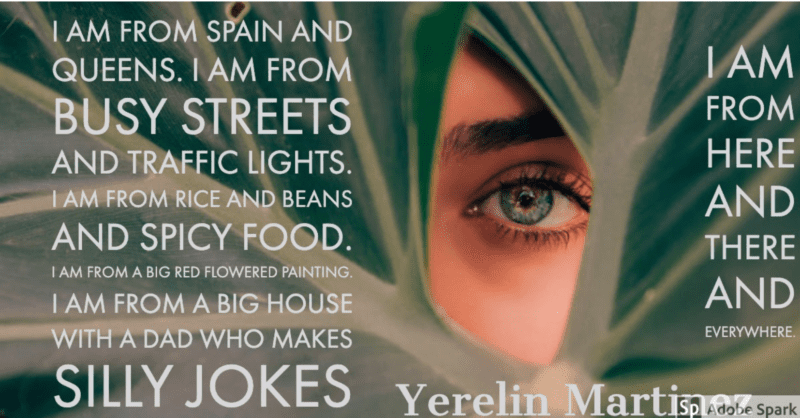
Students read the poem “I am From” by George Ella Lyon. Then, they draft a poem about their own identity in the same format Lyon used. Finally, students create a video to publish their poems. We love this one because the mentor text gives a clear structure and example that students can follow. But the end result is truly unique, just like their story.
2. Design a social media post to share an important memory

How can you use your unique perspective to tell a story? We want our students to learn that they are truly unique and have stories that only they can tell that other people want to hear or could relate to or learn from. In this activity, students watch two Pixar-in-a-Box videos on Khan Academy to learn about storytelling and perspective. Then, they identify an interesting or poignant memory and design a social media post.
3. Create an image using a line to chart an emotional journey

How do you show emotion using a single line? In this activity, students watch a Pixar in a Box video on Khan Academy to learn about how lines communicate character, emotion, and tension. Then they experiment with these aspects as they write their story. We love using this for pre-writing and to help students explore their story arc. Also, for students who love to draw or learn visually, this can help them get started telling their story and show them that there are many different ways to tell a story.
4. Tell the story behind your name

Sharing the story behind our name is a way to tell a story about ourselves, our culture, and our family history. And if there isn’t a story behind it, we can talk about how we feel about it and describe what it sounds like. In this activity, students use video to introduce themselves to their classmates by discussing the origin of their name. This project asks students to connect their names (and identities) to their personal and familial histories and to larger historical forces. If you’re looking for a mentor text that pairs well with this one, try “My Name” by Sandra Cisneros .
5. Develop a visual character sketch
Give students the time to create a character sketch of themselves. This will help them see how they fit into their story. In this lesson, students create a visual character sketch. They’ll treat themselves like a character and learn to see themselves objectively.
6. Create a webpage to outline the story of your movie

Building a story spine is a great way to show students how to put the parts of their story in an order that makes sense. It’s an exercise in making choices about structure. We like this activity because it gives students a chance to see different examples of structure in storytelling. Then, they consider the question: how can you use structure to set your story up for success? Finally, they design and illustrate an outline for their story.
7. Respond to a variety of writing prompts
Sometimes our students get stuck because they aren’t inspired or need a different entry point into telling their story. Give them a lot of writing prompts that they can choose from. Pass out paper and pencils. Set a timer for fifteen minutes. Then, write 3-4 writing prompts on the board. Encourage students to free-write and not worry about whether their ideas are good or right. Some of our favorite prompts to encourage students to tell their story are:
- I don’t know why I remember…
- What’s your favorite place and why?
- What objects tell the story of your life?
- What might surprise someone to learn about you?
8. Create a self-portrait exploring identity and self-expression
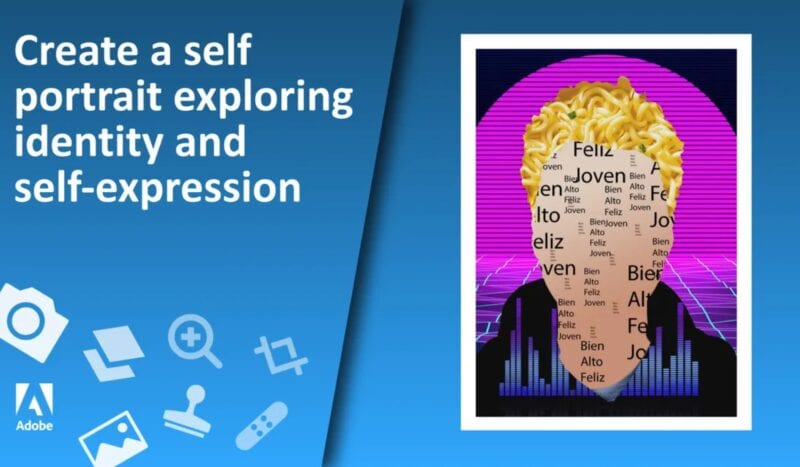
Part of what makes writing your own story so difficult for students is that they are just building their identity. In this activity, students explore how they and others define their identity. What role does identity play in determining how they are perceived and treated by others? What remains hidden and what is shown publicly?
9. Film a video to share an important story from your life

Encourage students to think about how to tell the story of a day they faced their fears. Students consider the question: How can you use different shot types to tell your story? They watch a video from Pixar in a Box on Khan Academy to learn about different camera shots and their use in storytelling. Then, they use Adobe Spark Post or Photoshop and choose three moments from their story to make into shots. We love using this to help students think about pace and perspective. Sometimes what we leave out of our story is just as important as what we include.
10. Try wild writing
Laurie Powers created a process where you read a poem and then select two lines from it. Students start their own writing with one of those lines. Anytime that they get stuck, they repeat their jump-off line again. This is a standalone activity or a daily writing warm-up, and it works with any poem. We love how it lowers the stakes. Can’t think of anything to write? Repeat the jump-off line and start again. Here are some of our favorite jump-off lines:
- The truth is…
- Some people say…
- Here’s what I forgot to tell you…
- Some questions have no answers…
- Here’s what I’m afraid to write about…
You Might Also Like
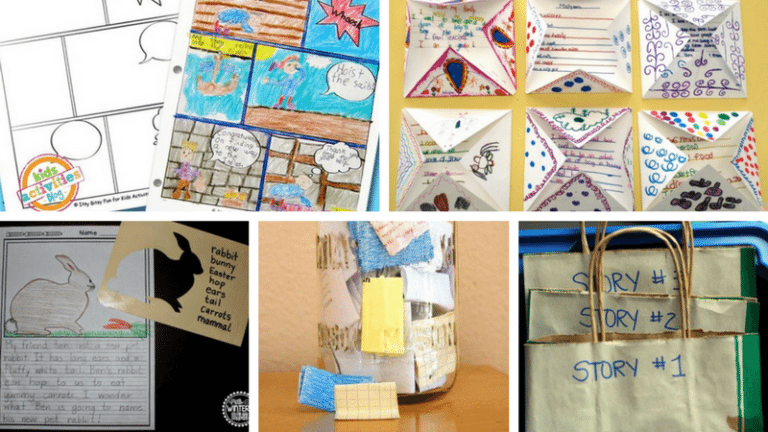
10 Writing Center Ideas We Love
Creative writing choices to spark their imaginations. Continue Reading
Copyright © 2024. All rights reserved. 5335 Gate Parkway, Jacksonville, FL 32256
- PRO Courses Guides New Tech Help Pro Expert Videos About wikiHow Pro Upgrade Sign In
- EDIT Edit this Article
- EXPLORE Tech Help Pro About Us Random Article Quizzes Request a New Article Community Dashboard This Or That Game Popular Categories Arts and Entertainment Artwork Books Movies Computers and Electronics Computers Phone Skills Technology Hacks Health Men's Health Mental Health Women's Health Relationships Dating Love Relationship Issues Hobbies and Crafts Crafts Drawing Games Education & Communication Communication Skills Personal Development Studying Personal Care and Style Fashion Hair Care Personal Hygiene Youth Personal Care School Stuff Dating All Categories Arts and Entertainment Finance and Business Home and Garden Relationship Quizzes Cars & Other Vehicles Food and Entertaining Personal Care and Style Sports and Fitness Computers and Electronics Health Pets and Animals Travel Education & Communication Hobbies and Crafts Philosophy and Religion Work World Family Life Holidays and Traditions Relationships Youth
- Browse Articles
- Learn Something New
- Quizzes Hot
- This Or That Game
- Train Your Brain
- Explore More
- Support wikiHow
- About wikiHow
- Log in / Sign up
- Education and Communications
- Writing Techniques
How to Teach Creative Writing
Last Updated: March 13, 2024 References
This article was co-authored by Christopher Taylor, PhD . Christopher Taylor is an Adjunct Assistant Professor of English at Austin Community College in Texas. He received his PhD in English Literature and Medieval Studies from the University of Texas at Austin in 2014. There are 13 references cited in this article, which can be found at the bottom of the page. This article has been viewed 117,288 times.
Creative writing is one of the most enjoyable types of writing for students. Not only does it allow students to explore their imaginations, but it helps them to structure their ideas and produce writing that they can be proud of. However, creative writing is a relatively difficult type of writing to teach and offers challenges to both new and seasoned teachers alike. Fortunately, though, with some work of their own, teachers can better develop their own abilities to teach creative writing.
Providing Students with the Fundamentals

- Theme. The theme of a story is its message or the main idea behind it.
- Setting. The setting of a story is the location or time it takes place in.
- Plot. The plot is the overall story, narrative, or sequence of events.
- Characterization. Characterization is how a character or person in a story is explained or presented to the reader.
- Conflict and dramatic action. Conflict and dramatic action are the main events of focus in the story. These events are often tense or exciting and are used to lure the reader in. [1] X Research source

- Explain how your students, as writers, can appeal to the humanity of their readers. One great way to do this is to ask them to explore character development. By developing the characters in their story, readers will become invested in the story.
- Discuss the triggers that engage readers in an effective story. Most great stories start with a problem, which is solved with the resolution, or conclusion of the story. Encourage students to create an engaging problem that will hook the readers in the first few pages of a short story or novel. [2] X Research source

- By setting the tone and atmosphere of a story, the author will establish his or her attitude to the subject and the feel of the story.
- Tone can be positive, neutral, or negative. [3] X Research source
- Atmosphere can be dark, happy, or neither.
- Descriptive words like “darkness” or “sunshine” can help set both the tone and atmosphere. [4] X Research source

- Active verbs are used to show action in the story.
- Active verbs are very often a better alternative to passive voice, as it keeps your writing clear and concise for your readers. [5] X Research source
- For example, instead of writing “The cat was chased by the dog” your student can write “The dog chased the cat.”
Guiding Students through the Process

- Tell your students to brainstorm about ideas they are truly interested in.
- If you must restrict the general topic, make sure that your students have a good amount of wiggle room within the broad topic of the assignment.
- Never assign specific topics and force students to write. This will undermine the entire process. [6] X Research source

- Letting your students know that the outline is non-binding. They don’t have to follow it in later steps of the writing process.
- Telling your students that the parts of their outline should be written very generally.
- Recommending that your students create several outlines, or outlines that go in different directions (in terms of plot and other elements of storytelling). The more avenues your students explore, the better. [7] X Research source

- Tell students that there is no “right” way to write a story.
- Let students know that their imaginations should guide their way.
- Show students examples of famous writing that breaks normal patterns, like the works of E.E. Cummings, William Faulkner, Charles Dickens, and William Shakespeare.
- Ask students to forget about any expectations they think you have for how a story should be written. [8] X Research source

- Gather the first drafts and comment on the student's work. For first drafts, you want to check on the overall structure of the draft, proper word use, punctuation, spelling, and overall cohesion of the piece. [9] X Research source
- Remind them that great writers usually wrote several drafts before they were happy with their stories.
- Avoid grading drafts for anything other than completion.

- Let students pair off to edit each others' papers.
- Have your students join groups of 3 or 4 and ask them to go edit and provide feedback on each member’s story.
- Provide guidance so students contribute constructively to the group discussion. [10] X Research source

- Reward your students if they are innovative or do something unique and truly creative.
- Avoid evaluating your students based on a formula.
- Assess and review your own standards as often as you can. Remember that the point is to encourage your students' creativity. [11] X Research source
Spurring Creativity

- Teach your students about a variety of writers and genres.
- Have your students read examples of different genres.
- Promote a discussion within your class of the importance of studying literature.
- Ask students to consider the many ways literature improves the world and asks individuals to think about their own lives. [12] X Research source

- Make sure your room is stocked with a wide variety of fiction stories.
- Make sure your room is stocked with plenty of paper for your students to write on.
- Line up other writing teachers or bring in writers from the community to talk to and encourage your students.

- Cut out pictures and photographs from magazines, comic books, and newspapers.
- Have your students cut out photographs and pictures and contribute them to your bank.
- Consider having your students randomly draw a given number of photos and pictures and writing a short story based on what they draw.
- This technique can help students overcome writer's block and inspire students who think that they're "not creative." [13] X Research source

- Pair your students with students from another grade in your school.
- Allow your students to write stories that younger students in your school would like to read.
- Pair your students with another student in the class and have them evaluate each others' work. [14] X Research source

- If you just have a typical classroom to work with, make sure to put inspirational posters or other pictures on the walls.
- Open any curtains so students can see outside.
- If you have the luxury of having an extra classroom or subdividing your own classroom, create a comfortable space with a lot of inspirational visuals.
- Writing spaces can help break writer's block and inspire students who think that they're "not creative." [15] X Research source

- Involve students in the printing process.
- Publication does not have to be expensive or glossy.
- Copies can be made in the school workroom if possible or each student might provide a copy for the others in the group.
- A collection of the stories can be bound with a simple stapler or brads.
- Seek out other opportunities for your students to publish their stories.
Expert Q&A

You Might Also Like

- ↑ https://www.writersonlineworkshops.com/courses/creative-writing-101
- ↑ https://kobowritinglife.com/2012/10/14/six-tips-for-engaging-readers-within-two-seconds-the-hook-in-fiction-and-memoir/
- ↑ https://www.dailywritingtips.com/in-writing-tone-is-the-author%E2%80%99s-attitude/
- ↑ http://ourenglishclass.net/class-notes/writing/the-writing-process/craft/tone-and-mood/
- ↑ https://owl.english.purdue.edu/owl/resource/539/02/
- ↑ http://www.alfiekohn.org/article/choices-children/
- ↑ https://www.writersdigest.com/write-better-fiction/7-steps-to-creating-a-flexible-outline-for-any-story
- ↑ http://thewritepractice.com/the-formula-to-write-a-novel/
- ↑ https://student.unsw.edu.au/editing-your-essay
- ↑ http://orelt.col.org/module/unit/5-promoting-creative-writing
- ↑ http://education.seattlepi.com/grade-creative-writing-paper-3698.html
- ↑ http://www.theatlantic.com/education/archive/2016/04/educating-teenagers-emotions-through-literature/476790/
- ↑ http://www.wrightingwords.com/for-teachers/5-tips-for-teaching-creative-writing/
About This Article

To teach creative writing, start by introducing your students to the core elements of storytelling, like theme, setting, and plot, while reminding them that there’s no formula for combining these elements to create a story. Additionally, explain how important it is to use tone and atmosphere, along with active verbs, to write compelling stories that come alive. When your students have chosen their topics, have them create story outlines before they begin writing. Then, read their rough drafts and provide feedback to keep them on the right path to storytelling success. For tips from our English reviewer on how to spur creativity in your students, read on! Did this summary help you? Yes No
- Send fan mail to authors
Reader Success Stories
Yunzhe Yang
Mar 27, 2017
Did this article help you?

Daniel Hesse
Dec 5, 2016

Featured Articles

Trending Articles

Watch Articles

- Terms of Use
- Privacy Policy
- Do Not Sell or Share My Info
- Not Selling Info
Don’t miss out! Sign up for
wikiHow’s newsletter
You are using an outdated browser. Please upgrade your browser to improve your experience.
How to Teach Creative Writing | 7 Steps to Get Students Wordsmithing

“I don’t have any ideas!”
“I can’t think of anything!”
While we see creative writing as a world of limitless imagination, our students often see an overwhelming desert of “no idea.”
But when you teach creative writing effectively, you’ll notice that every student is brimming over with ideas that just have to get out.
So what does teaching creative writing effectively look like?
We’ve outlined a seven-step method that will scaffold your students through each phase of the creative process from idea generation through to final edits.
7. Create inspiring and original prompts
Use the following formats to generate prompts that get students inspired:
- personal memories (“Write about a person who taught you an important lesson”)
- imaginative scenarios
- prompts based on a familiar mentor text (e.g. “Write an alternative ending to your favorite book”). These are especially useful for giving struggling students an easy starting point.
- lead-in sentences (“I looked in the mirror and I couldn’t believe my eyes. Somehow overnight I…”).
- fascinating or thought-provoking images with a directive (“Who do you think lives in this mountain cabin? Tell their story”).

Don’t have the time or stuck for ideas? Check out our list of 100 student writing prompts
6. unpack the prompts together.
Explicitly teach your students how to dig deeper into the prompt for engaging and original ideas.
Probing questions are an effective strategy for digging into a prompt. Take this one for example:
“I looked in the mirror and I couldn’t believe my eyes. Somehow overnight I…”
Ask “What questions need answering here?” The first thing students will want to know is:
What happened overnight?
No doubt they’ll be able to come up with plenty of zany answers to that question, but there’s another one they could ask to make things much more interesting:
Who might “I” be?
In this way, you subtly push students to go beyond the obvious and into more original and thoughtful territory. It’s even more useful with a deep prompt:
“Write a story where the main character starts to question something they’ve always believed.”
Here students could ask:
- What sorts of beliefs do people take for granted?
- What might make us question those beliefs?
- What happens when we question something we’ve always thought is true?
- How do we feel when we discover that something isn’t true?
Try splitting students into groups, having each group come up with probing questions for a prompt, and then discussing potential “answers” to these questions as a class.
The most important lesson at this point should be that good ideas take time to generate. So don’t rush this step!
5. Warm-up for writing
A quick warm-up activity will:
- allow students to see what their discussed ideas look like on paper
- help fix the “I don’t know how to start” problem
- warm up writing muscles quite literally (especially important for young learners who are still developing handwriting and fine motor skills).
Freewriting is a particularly effective warm-up. Give students 5–10 minutes to “dump” all their ideas for a prompt onto the page for without worrying about structure, spelling, or grammar.
After about five minutes you’ll notice them starting to get into the groove, and when you call time, they’ll have a better idea of what captures their interest.
Did you know? The Story Factory in Reading Eggs allows your students to write and publish their own storybooks using an easy step-by-step guide.

4. Start planning
Now it’s time for students to piece all these raw ideas together and generate a plan. This will synthesize disjointed ideas and give them a roadmap for the writing process.
Note: at this stage your strong writers might be more than ready to get started on a creative piece. If so, let them go for it – use planning for students who are still puzzling things out.
Here are four ideas for planning:
Graphic organisers
A graphic organiser will allow your students to plan out the overall structure of their writing. They’re also particularly useful in “chunking” the writing process, so students don’t see it as one big wall of text.
Storyboards and illustrations
These will engage your artistically-minded students and give greater depth to settings and characters. Just make sure that drawing doesn’t overshadow the writing process.
Voice recordings
If you have students who are hesitant to commit words to paper, tell them to think out loud and record it on their device. Often they’ll be surprised at how well their spoken words translate to the page.
Write a blurb
This takes a bit more explicit teaching, but it gets students to concisely summarize all their main ideas (without giving away spoilers). Look at some blurbs on the back of published books before getting them to write their own. Afterward they could test it out on a friend – based on the blurb, would they borrow it from the library?
3. Produce rough drafts
Warmed up and with a plan at the ready, your students are now ready to start wordsmithing. But before they start on a draft, remind them of what a draft is supposed to be:
- a work in progress.
Remind them that if they wait for the perfect words to come, they’ll end up with blank pages .
Instead, it’s time to take some writing risks and get messy. Encourage this by:
- demonstrating the writing process to students yourself
- taking the focus off spelling and grammar (during the drafting stage)
- providing meaningful and in-depth feedback (using words, not ticks!).

Reading Eggs also gives you access to an ever-expanding collection of over 3,500 online books!
2. share drafts for peer feedback.
Don’t saddle yourself with 30 drafts for marking. Peer assessment is a better (and less exhausting) way to ensure everyone receives the feedback they need.
Why? Because for something as personal as creative writing, feedback often translates better when it’s in the familiar and friendly language that only a peer can produce. Looking at each other’s work will also give students more ideas about how they can improve their own.
Scaffold peer feedback to ensure it’s constructive. The following methods work well:
Student rubrics
A simple rubric allows students to deliver more in-depth feedback than “It was pretty good.” The criteria will depend on what you are ultimately looking for, but students could assess each other’s:
- use of language.
Whatever you opt for, just make sure the language you use in the rubric is student-friendly.
Two positives and a focus area
Have students identify two things their peer did well, and one area that they could focus on further, then turn this into written feedback. Model the process for creating specific comments so you get something more constructive than “It was pretty good.” It helps to use stems such as:
I really liked this character because…
I found this idea interesting because it made me think…
I was a bit confused by…
I wonder why you… Maybe you could… instead.
1. The editing stage
Now that students have a draft and feedback, here’s where we teachers often tell them to “go over it” or “give it some final touches.”
But our students don’t always know how to edit.
Scaffold the process with questions that encourage students to think critically about their writing, such as:
- Are there any parts that would be confusing if I wasn’t there to explain them?
- Are there any parts that seem irrelevant to the rest?
- Which parts am I most uncertain about?
- Does the whole thing flow together, or are there parts that seem out of place?
- Are there places where I could have used a better word?
- Are there any grammatical or spelling errors I notice?
Key to this process is getting students to read their creative writing from start to finish .
Important note: if your students are using a word processor, show them where the spell-check is and how to use it. Sounds obvious, but in the age of autocorrect, many students simply don’t know.
A final word on teaching creative writing
Remember that the best writers write regularly.
Incorporate them into your lessons as often as possible, and soon enough, you’ll have just as much fun marking your students’ creative writing as they do producing it.
Need more help supporting your students’ writing?
Read up on how to get reluctant writers writing , strategies for supporting struggling secondary writers , or check out our huge list of writing prompts for kids .

Watch your students get excited about writing and publishing their own storybooks in the Story Factory
You might like....
- Become a Hope Brand Influencer
12 ideas for teaching creative writing

Teaching creative writing to kids can be one of the most rewarding parts of teaching the English curriculum. But with so many statutory requirements to hit in a portfolio of writing, it can be difficult to capture truly creative writing as well as instil enthusiasm for the art.
Some of your class will really enjoy creative writing from scratch. For others, this will be a daunting experience. We have gathered together a collection of simple ideas for teaching creative writing to help your pupils smash writing tasks.
Creative writing tips for teachers
- Use a workshop-style environment
- Show your class how it’s done
- Draw up a storyboard
- Encourage book reading
- Re-write a known story
- Show, don’t tell
- Inspire them with video
- Deconstruct characters
- Give your pupils freedom
- Use story-starters and prompts
- Elaborate with a story generator
- Get the children to take creative writing home
1. Use a workshop-style environment
Separate your class into groups or tables, each group will then be able to choose what they work on. Some may look to write fiction pieces and use ideas around storytelling. Another group could focus on word games, spelling and puzzle-solving. There could even just be a group for reading stories and learning the craft!
All children are able to work in groups, but each pupil will have one-to-one time with you too. As long as assignments and tasks are rotated, children will find their favourite part and be more engaged as a result. Working this way can also lead to competitions and collaborative creative writing work.
2. Show your class how it’s done
The adage is ‘practise what you preach’. When it comes to creative writing, this means you should be showing the class what the process is.
Doing live creative writing sessions for your class can give them perspective on how to build a story effectively. More importantly, it gives them chance to see how it’s OK to make mistakes, how to take criticism and that they shouldn’t be afraid to create whatever they feel they want to. You could even get your more able (and confident!) pupils to live write on the board for the class to gather inspiration from; pupil modelling can be a really fantastic assessment for learning activity.
3. Draw up a storyboard
Some visual cues might be the key to unlocking greater creativity in your pupils. Instead of writing out a story, why not begin with a storyboard? It doesn’t need to be a work of art – simple stick people will do the job.
Once you’ve drawn out the basis of your story, you can then start to write down more detail to really flesh out their story.
4. Encourage book reading
If there is one place anyone can go to experience good storytelling, it’s in books. Reading brings a whole host of benefits to children form an educational standpoint – many of which apply to creative writing.
To increase vocabulary, improve creativity and enflame imaginations (plus a whole lot more), we should always be looking for more reading opportunities for pupils in class. Beyond the classroom, encourage them to do as much reading as possible at home too.
5. Re-write a known story
If you’re struggling for ideas, why not take inspiration from one of the countless legendary stories already out there. Give a classic story a twist and ask the class to elaborate on it:
- Three Billy Goats Gruff are the ones under the bridge, and you’re trying to cross it
- At the top of Jack’s Beanstalk is Mars
- Aladdin rubs his lamp, but what are his three wishes?
- The three bears are the ones sneaking into Goldilocks’ house
6. Show, don’t tell
It’s a tenant of good storytelling across many different mediums. The idea of show, don’t tell means the writer should avoid explaining every aspect of what a character is feeling or thinking and instead focus on different ways of revealing that information in the story.
For example, give your class some basic information like “the boy was sad”, and ask to write a sentence that would display that information more creatively. It could become, “the boy’s heart sank, his head bowed and he sniffled as the tears began to fall.”
This way, the reader is able to unravel the emotions involved in the story themselves, rather than being told.
7. Inspire them with video
YouTube is a treasure trove of learning resources and other helpful content that can boost a pupil’s creative writing capability. With a quick search, you’ll find plenty of interviews with famed writers sharing their experiences in the job.
Use these to dig a little deeper into the mind of a writer. What is there process for coming up with ideas? What are the challenges they face? This type of content can provide key takeaways that pupils can bring into their next creative writing task.
8. Deconstruct characters
A simple but effective method for getting into the routine of character building involves writing down what makes them tick. Take a famous character from a book or a famous children’s TV show. Split a piece of paper into a grid, and label them with things like “what makes them happy”, “what makes them angry” “How would they react in a certain situation?”
Then as a class fill out the grid. You could use them method when a pupil comes up with a new character for their story, helping them to get in the correct mindsight for creating characters.
9. Give your pupils freedom
There will be a lot of children in your class who thrive when given the freedom to write. Always remember to set aside time for your pupils to have an open-ended opportunity to write, allowing them to express their favourite topics. If it’s too open for some children, then proposing a particular topic for this time can help too.
10. Use story-starters and prompts
Story-starters or prompts are great for getting the creative juices flowing. It helps pupils to avoid the dreaded ‘writer’s block’. We’ve got a whole load of story starters for KS1 and KS2 creative writers, but here are just a few to get the juices flowing:
- It was there and then it was gone! As quick as a flash…
- This was it! I now had the power to change anything.
- A million pounds sat there in the suitcase. “What should we do with it?” I said.
- The three friends set out on their journey, with nothing but each other to help them for what lied ahead.
- The car lurched down the road when suddenly a thud came from below.
- The tap on my shoulder woke me. “Shhh” she said with a finger pressed to her lips. “Follow me.”
11. Elaborate with a story generator
Generate ideas and get a story rolling with a tried and tested method: the story generator. Here is a step-by-step guide on how to do it:
- Find three bags
- Create three lists: one for characters (a footballer, a dog, an astronaut etc), one for scenes (an unknown planet, a bedroom, a park etc) and one for the situation (looking for a lost coin, meets a talking dog, during a big thunderstorm etc)
- Cut out each of the ideas and group them together in the bags. You have three bags filled with dozens of possibilities for different stories.
- Ask a pupil to reach into each bag so they then have a character, a scene and a situation. This is the basis of their story.
12. Get the children to take creative writing home
The home environment will be a more comfortable or possibly, a more inspiring place for children to write their stories. Encouraging parents to get onside with this can sometimes be a battle, but one worth fighting. Sharing their stories and creations across different audiences is a valuable experience for children, whether that be in class, at home or safely online. The perfect flipped classroom experience!

Amber Vaccianna
Hope Education writer
Advice & Inspiration | Primary
9 october 2020.
You May Also Like…

Stress Relief Tips for Children
18 Mar 2024 | Advice & Inspiration , Health & Wellbeing , Primary
Openly talking...

5 steps to managing big emotions- free downloadable poster
21 Feb 2024 | Health & Wellbeing , Primary
5 steps to...
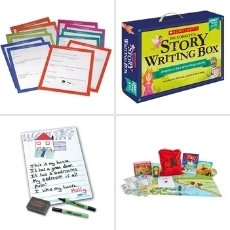
Explore English writing resources
Pin it on pinterest.

10 fun writing activities for the reluctant writer
10 FUN WRITING ACTIVITIES FOR THE RELUCTANT WRITER
No doubt about it – writing isn’t easy. It is no wonder that many of our students could be described as ‘reluctant writers’ at best. It has been estimated by the National Association of Educational Progress that only about 27% of 8th and 12th-grade students can write proficiently.
As educators, we know that regular practice would go a long way to helping our students correct this underachievement, and sometimes, writing prompts just aren’t enough to light the fire.
But how do we get students, who have long since been turned off writing, to put pen to paper and log the requisite time to develop their writing chops?
The answer is to make writing fun! In this article, we will look at some creative writing activities where we can inject a little enjoyment into the writing game.

25 Fun Daily Writing Tasks
Quick Write and JOURNAL Activities for ALL TEXT TYPES in DIGITAL & PDF PRINT to engage RELUCTANT WRITERS .
⭐⭐⭐⭐⭐ ( 18 reviews )
1. Poetry Scavenger Hunt

The Purpose: This activity encourages students to see the poetry in the everyday language around them while helpfully reinforcing their understanding of some of the conventions of the genre.
The Process: Encourage students to ‘scavenge’ their school, home, and outside the community for snippets of language they can compile into a piece of poetry or a poetic collage. They may copy down or photograph words, phrases, and sentences from signs, magazines, leaflets or even snippets of conversations they overhear while out and about.
Examples of language they collect may range from the Keep Out sign on private property to the destination on the front of a local bus.
Once students have gathered their language together, they can work to build a poem out of the scraps, usually choosing a central theme to give the piece cohesion. They can even include corresponding artwork to enhance the visual appeal of their work, too, if they wish.
The Prize: If poetry serves one purpose, it is to encourage us to look at the world anew with the fresh eyes of a young child. This activity challenges our students to read new meanings into familiar things and put their own spin on the language they encounter in the world around them, reinforcing the student’s grasp on poetic conventions.
2. Story Chains
The Purpose: Writing is often thought of as a solitary pursuit. For this reason alone, it can be seen as a particularly unattractive activity by many of our more gregarious students. This fun activity exercises students’ understanding of writing structures and engages them in fun, creative collaboration.
The Process: Each student starts with a blank paper and pen. The teacher writes a story prompt on the whiteboard. You’ll find some excellent narrative writing prompts here . For example, each student spends two minutes using the writing prompt to kick-start their writing.
When they have completed this part of the task, they will then pass their piece of paper to the student next to them. Students then continue the story from where the previous student left off for a given number of words, paragraphs, or length of time.
If organized correctly, you can ensure students receive their own initial story back at the end for the writing of the story’s conclusion .
The Prize: This fun writing activity can be used effectively to reinforce student understanding of narrative writing structures, but it can also be fun to try with other writing genres.
Working collaboratively motivates students to engage with the task, as no one wants to be the ‘weak link’ in the finished piece. But, more than that, this activity encourages students to see writing as a communicative and creative task where there needn’t be a ‘right’ answer. This encourages students to be more willing to take creative risks in their work.
3. Acrostic Associations
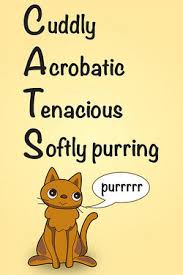
The Purpose: This is another great way to get students to try writing poetry – a genre that many students find the most daunting.
The Process: Acrostics are simple poems whereby each letter of a word or phrase begins a new line in the poem. Younger students can start off with something very simple, like their own name or their favorite pet and write this vertically down the page.
Older students can take a word or phrase related to a topic they have been working on or have a particular interest in and write it down on the page before beginning to write.
The Prize: This activity has much in common with the old psychiatrist’s word association technique. Students should be encouraged to riff on ideas and themes generated by the focus word or phrase. They needn’t worry about rhyme and meter and such here, but the preset letter for each line will give them some structure to their meanderings and require them to impose some discipline on their wordsmithery, albeit in a fun and loose manner.
4. The What If Challenge

The Purpose: This challenge helps encourage students to see the link between posing interesting hypothetical questions and creating an entertaining piece of writing.
The Process: To begin this exercise, have the students come up with a single What If question, which they can then write down on a piece of paper. The more off-the-wall, the better!
For example, ‘What if everyone in the world knew what you were thinking?’ or ‘What if your pet dog could talk?’ Students fold up their questions and drop them into a hat. Each student picks one out of the hat before writing on that question for a suitable set amount of time.
Example What If Questions
- “What if you woke up one day and found out that you had the power to time travel?”
- “What if you were the last person on Earth? How would you spend your time?”
- “What if you were granted three wishes, but each one came with a terrible consequence?”
- “What if you discovered a secret portal to another world? Where would you go, and what would you do?”
- “What if you woke up one day with the ability to communicate with animals? How would your life change?”
The Prize: Students are most likely to face the terror of the dreaded Writer’s Block when they are faced with open-ended creative writing tasks.
This activity encourages the students to see the usefulness of posing hypothetical What If questions, even random off-the-wall ones, for kick-starting their writing motors.
Though students begin by answering the questions set for them by others, please encourage them to see how they can set these questions for themselves the next time they suffer from a stalled writing engine.
5. The Most Disgusting Sandwich in the World

The Purpose: Up until now, we have looked at activities encouraging our students to have fun with genres such as fiction and poetry. These genres being imaginative in nature, more easily lend themselves to being enjoyable than some of the nonfiction genres.
But what about descriptive writing activities? In this activity, we endeavor to bring that same level of enjoyment to instruction writing while also cleverly reinforcing the criteria of this genre.
The Process: Undoubtedly, when teaching instruction writing, you will at some point cover the specific criteria of the genre with your students.
These will include things like the use of a title, numbered or bulleted points, time connectives, imperatives, diagrams with captions etc. You will then want the students to produce their own piece of instruction writing or procedural text to display their understanding of how the genre works.
But, why not try a fun topic such as How to Make the Most Disgusting Sandwich in the World rather than more obvious (and drier!) topics such as How to Tie Your Shoelaces or How to Make a Paper Airplane when choosing a topic for your students to practice their instruction writing chops?
Example of a Most Disgusting Sandwich Text
The Prize: As mentioned, with nonfiction genres, in particular, we tend to suggest more banal topics for our students to work on while internalizing the genre’s criteria. Enjoyment and acquiring practical writing skills need not be mutually exclusive.
Our students can just as quickly, if not more easily, absorb and internalize the necessary writing conventions while engaged in writing about whimsical and even nonsensical topics.
if your sandwich is entering the realm of horror, be sure to check our complete guide to writing a scary story here as well.
Daily Quick Writes For All Text Types

Our FUN DAILY QUICK WRITE TASKS will teach your students the fundamentals of CREATIVE WRITING across all text types. Packed with 52 ENGAGING ACTIVITIES
6. Diary Entry of a Future Self

The Purpose: This activity allows students to practice personal writing within diary/journal writing conventions. It also challenges them to consider what their world will be like in the future, perhaps stepping a foot into the realm of science fiction.
The Process: Straightforwardly, after working through some examples of diary or journal writing, and reviewing the various criteria of the genre, challenge the students to write an entry at a given milestone in the future.
This may be when they leave school, begin work, go to university, get married, have kids, retire, etc. You may even wish to get the students to write an entry for a series of future milestones as part of a more extended project.
Example of Message to Future Me Text
The Prize: Students will get a chance here to exercise their understanding of this type of writing , but more than that, they will also get an opportunity to exercise their imaginative muscles too. They will get to consider what shape their future world will take in this engaging thought experiment that will allow them to improve their writing too.
7. Comic Strip Script
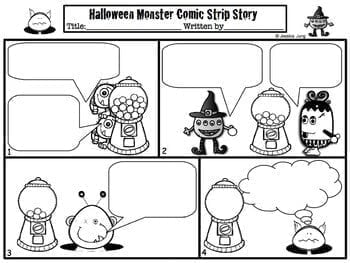
The Purpose: Give your students the chance to improve their dialogue writing skills and work on their understanding of character development in this fun activity which combines writing with a series of visual elements.
The Process: There are two ways to do this activity. The first requires you to source or create a comic strip without the dialogue the characters are speaking. This may be as straightforward as using whiteout to erase the words in speech bubbles and making copies for your students to complete.
Alternatively, provide the students with photographs/pictures and strips of cards to form their action sequences . When students have their ‘mute’ strips, they can begin to write the dialogue/script to link the panels together.
The Prize: When it comes to writing, comic strips are probably one of the easier sells to reluctant students! This activity also allows students to write for speech. This will stand to them later when they come to produce sections of dialogue in their narrative writing or when producing play or film scripts.
They will also develop their visual literacy skills as they scan the pictures for clues of tone and context before they begin their writing.
Keep It Fun
Just as we should encourage our students to read for fun and wider educational benefits, we should also work to instil similar attitudes towards writing. To do this means we must work to avoid always framing writing in the context of a chore, that bitter pill that must be swallowed for the good of our health.
There is no getting away from the fact that writing can, at times, be laborious. It is time-consuming and, for most of us, difficult at the best of times. There is a certain, inescapable amount of work involved in becoming a competent writer.
That said, as we have seen in the activities above, with a bit of creative thought, we can inject fun into even the most practical of writing activities . All that is required is a dash of imagination and a sprinkling of effort.
8. Character Interviews

The Purpose: Character interviews as writing activities are excellent for students because they encourage creative thinking, character development, and empathy. The purpose of this activity is to help students delve deeper into the minds of the characters they are creating in their stories or reading about in literature. By conducting interviews with these characters, students gain a better understanding of their personalities, motivations, and perspectives.
The Process of character interviews involves students imagining themselves as interviewers and their characters as interviewees. They can either write out the questions and answers in a script-like format or write a narrative where the character responds to the questions in their own voice.
The Prize: Through character interviews, students learn several valuable skills:
- Character Development: By exploring various aspects of their characters’ lives, backgrounds, and experiences, students can develop more well-rounded and authentic characters in their stories. This helps make their fictional creations more relatable and engaging to readers.
- Empathy and Perspective: Conducting interviews requires students to put themselves in their characters’ shoes, considering their thoughts, emotions, and struggles. This cultivates empathy and a deeper understanding of human behavior, which can be applied to real-life situations as well.
- Voice and Dialogue: In crafting the character’s responses, students practice writing authentic dialogue and giving their characters unique voices. This skill is valuable for creating dynamic and believable interactions between characters in their stories.
- Creative Expression: Character interviews provide a creative outlet for students to let their imaginations run wild. They can explore scenarios that may not appear in the main story and discover new aspects of their characters they might not have considered before.
- Critical Thinking: Formulating questions for the interview requires students to think critically about their characters’ personalities and backgrounds. This exercise enhances their analytical skills and storytelling abilities.
Overall, character interviews are a dynamic and enjoyable way for students to delve deeper into the worlds they create or the literature they read. It nurtures creativity, empathy, and writing skills, empowering students to become more proficient and imaginative writers.

9. The Travel Journal

The Purpose: Travel journal writing tasks are excellent for students as they offer a unique and immersive way to foster creativity, cultural awareness, and descriptive writing skills. The purpose of this activity is to allow students to embark on a fictional or real travel adventure, exploring new places, cultures, and experiences through the eyes of a traveller.
The process of a travel journal writing task involves students assuming the role of a traveler and writing about their journey in a journal format. They can describe the sights, sounds, tastes, and emotions they encounter during their travels. This activity encourages students to use vivid language, sensory details, and expressive writing to bring their travel experiences to life.
The Prize: Through travel journal writing tasks, students will learn several valuable skills:
- Descriptive Writing: By describing their surroundings and experiences in detail, students enhance their descriptive writing skills, creating engaging and vivid narratives.
- Cultural Awareness: Travel journals encourage students to explore different cultures, customs, and traditions. This helps broaden their understanding and appreciation of diversity.
- Empathy and Perspective: Through writing from the perspective of a traveler, students develop empathy and gain insight into the lives of people from different backgrounds.
- Research Skills: For fictional travel journals, students might research specific locations or historical periods to make their narratives more authentic and accurate.
- Reflection and Self-Expression: Travel journals offer a space for students to reflect on their own emotions, thoughts, and personal growth as they encounter new experiences.
- Creativity and Imagination: For fictional travel adventures, students get to unleash their creativity and imagination, envisioning fantastical places and scenarios.
- Language and Vocabulary: Travel journal writing tasks allow students to expand their vocabulary and experiment with expressive language.
Overall, travel journal writing tasks inspire students to become more observant, empathetic, and skilled writers. They transport them to new worlds and foster a sense of wonder and curiosity about the world around them. Whether writing about real or imaginary journeys, students develop a deeper connection to the places they encounter, making this activity both educational and enjoyable.
10. The Fairy Tale Remix

The Purpose: A fairy tale remix writing activity is a fantastic creative exercise for students as it allows them to put a unique spin on classic fairy tales, fostering imagination, critical thinking, and storytelling skills. This activity encourages students to think outside the box, reinterpret well-known tales, and explore their creative potential by transforming traditional narratives into something entirely new and exciting.
The process of a fairy tale remix writing activity involves students selecting a familiar fairy tale and altering key elements such as characters, settings, plot twists, or outcomes. They can modernize the story, change the genre, or even mix different fairy tales together to create a wholly original piece.
The Prize: Through this activity, students will learn several valuable skills:
- Creative Thinking: Students exercise their creativity by brainstorming unique concepts and ideas to remix the fairy tales, encouraging them to think imaginatively.
- Critical Analysis: Analyzing the original fairy tale to identify essential elements to keep and areas to remix helps students develop critical thinking skills and understand storytelling structures.
- Writing Techniques: Crafting a remix requires students to use descriptive language, engaging dialogue, and well-developed characters, helping them hone their writing techniques.
- Perspective and Empathy: Remixing fairy tales allows students to explore different character perspectives, promoting empathy and understanding of diverse points of view.
- Genre Exploration: Remixing fairy tales can introduce students to various genres like science fiction, fantasy, or mystery, expanding their literary horizons.
- Originality: Creating their own narrative twists and unexpected plots encourages students to take ownership of their writing and develop a unique voice.
- Storytelling: Students learn the art of compelling storytelling as they weave together familiar elements with innovative ideas, captivating their readers.
By remixing fairy tales, students embark on a creative journey that empowers them to reimagine well-loved stories while honing their writing skills and imaginative prowess. It’s an engaging and enjoyable way for students to connect with literature, explore new possibilities, and showcase their storytelling talents.
Top 5 Tips for Teaching Engaging Creative Writing Lessons
Teaching creative writing can be a thrilling discovery journey for students and educators alike. To foster a love for storytelling and unleash the imaginative prowess of your students, here are five engaging tips for your creative writing lessons:
1. Embrace Playfulness : Encourage a spirit of playfulness and experimentation in your classroom. Encourage students to explore unconventional ideas, characters, and settings. Use fun writing prompts like “What if animals could talk?” or “Imagine a world where gravity is reversed.”
2. Incorporate Visual Stimuli : Visual aids can be powerful creative catalysts. Show intriguing images or short videos to spark students’ imaginations. Ask them to describe what they see, then guide them to weave stories around these visuals. This approach can lead to unexpected and captivating narratives.
3. Encourage Peer Collaboration : Foster community and collaboration among your students. Organize group writing activities where students can brainstorm, share ideas, and build upon each other’s stories. This not only enhances creativity but also promotes teamwork and communication skills.
4. Explore Different Genres : Introduce students to various writing genres—fantasy and science fiction to mystery and historical fiction. Let them experiment with different styles and find what resonates most with their interests. Exposing students to diverse genres can broaden their horizons and inspire fresh ideas.
5. Celebrate Individuality : Encourage students to infuse unique experiences and perspectives into their writing. Provide opportunities for them to write about topics that are meaningful to them. Celebrate their voices and help them discover the power of their narratives.
Remember, the key to teaching creative writing is to create a supportive and inspiring environment where students feel empowered to take risks and explore the limitless possibilities of storytelling. By embracing these tips, you can transform your classroom into a vibrant imagination and literary exploration hub. Happy writing!
MORE FUN WRITING ACTIVITIES FOR YOU
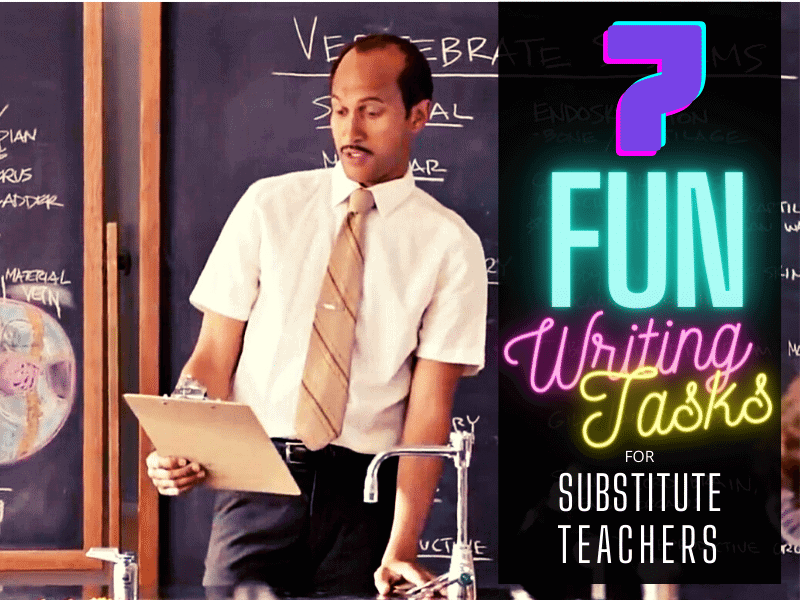
7 Fun Writing Sub Plans for Substitute Teachers

25 Fun Christmas Writing Tasks for Students

5 Fun Seasonal Writing Activities Students and Teachers Love

10 Fun Classroom Writing Games to Improve Literacy Skills
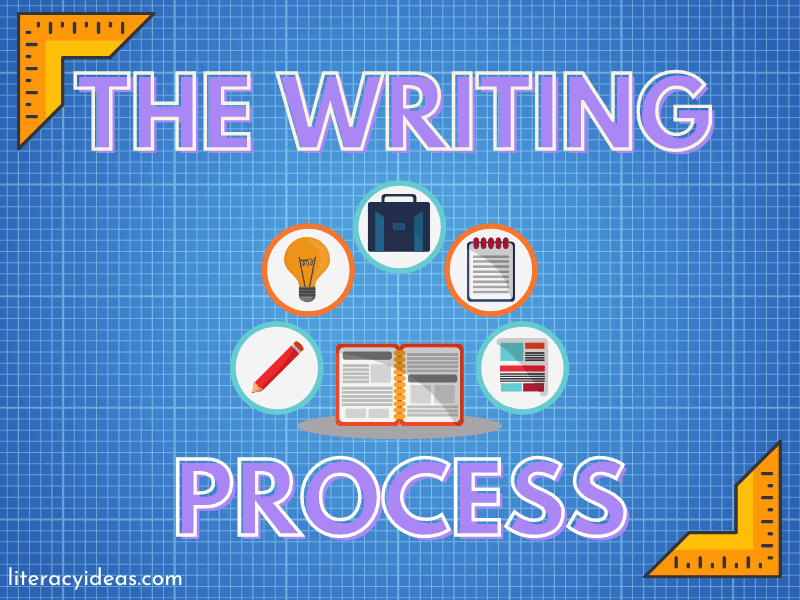
The Writing Process
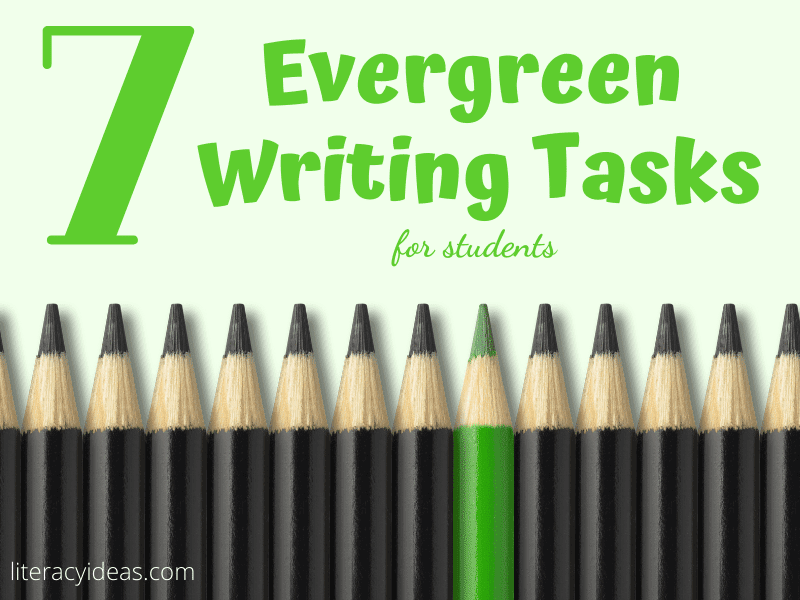
7 Evergreen Writing Activities for Elementary Students
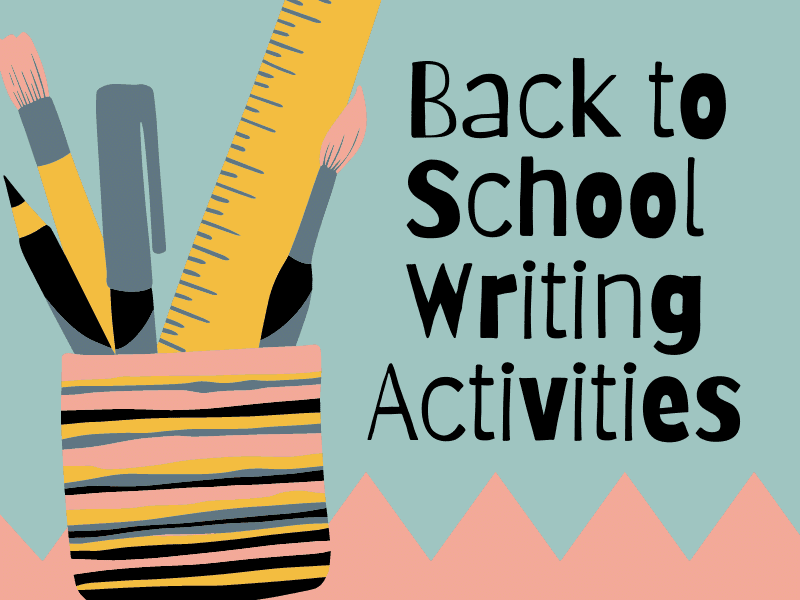
17 Fun First Day Of School Writing Activities
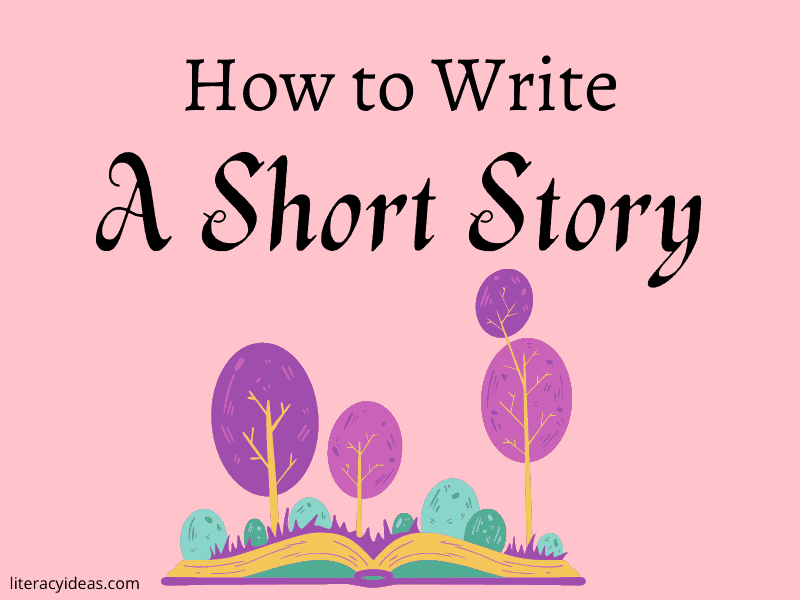
Short Story Writing for Students and Teachers

Teach Creative Writing In High School With 10 Fun Activities
Creative writing is a meaningful aspect of literature that mandates you to utilize your expertise, ingenuity, and story to depict a critical message, emotion, or plot. It defies the traditional bounds of other forms of writing and is completely subjective to our preferences and experiences. In creative writing, it’s all about imaginativeness!
Using creative imagination and originality to convey feelings and concepts in a unique way is at the heart of creative writing. Simply stated, it’s about infusing your own ‘flair’ into your writing, moving beyond academic or other technical kinds of literature.
In this post, we will explore the various activities which would be advantageous for a high schooler who wishes to indulge in creative writing!

What Happens When Creative Writing Is Put To Use?
Creative writing is any form of writing that deviates from traditional professional, investigative journalism, educational, or technological forms of literature. It is typically distinguished by emphasizing narrative craft, character development, literary tropes, or various poetic traditions.
Here are the few ways how high schoolers can benefit from creative writing –
1. Imagination
When you write creatively, you expand your imagination by creating new environments, scenarios, and characters. This way, you are also boosting and stretching your imagination, as well as “thinking out of the box.” This allows you to concentrate your energy on many other things and improve your ability to find fresh ideas and alternatives to problems you’re having. Whether you’re a researcher or a businessman, creative writing will increase your imagination and help you think more creatively, and push the boundaries.
2. Empathy and Communications skills
When you create characters, you’ll be constructing emotions, personalities, behaviors, and world views that are distinct from your own. Writers must conceive personalities, emotions, places, and walks of life outside of their own lives while creating universes with fictional characters and settings.
This can give children a good dose of empathy and understanding for those who aren’t like them, who don’t live where they do or go through the same things they do daily. Writers are better equipped to communicate when they have a greater understanding of other points of view. They can come up with creative ways to explain and debate subjects from multiple perspectives. This ability is crucial in both professional and personal situations.
3. Clarification of Thoughts
Creating structures in creative writing allows you to organize your impressions and emotions into a logical procedure. You may express both your thoughts and your sentiments through creative writing. For example, if you’re a marketing executive, you could create a short tale in which your clientele reads your promotional emails. You can guess what they’re up to, where they’re seated, what’s around them, and so on.
This enables you to focus on the language and strategies you employ. Alternatively, if you’re a technical writer writing on a new desktop platform, you could create a creative scenario in which a user encounters a problem.
4. Broadens Vocabulary and gets a better understanding of reading and writing
You’ll learn a larger vocabulary and a better understanding of the mechanics of reading and writing as you begin to practice writing exercises regularly. Even if you’re writing a budget report, you’ll know when rigid grammar standards work and when they don’t, and you’ll know what will make your writing flow better for your readers. Exploring different ways of expressing yourself when writing creatively allows you to extend your vocabulary.
You’ll notice a change in your use and range of language as you improve your writing over time, which will be useful in any professional route and social scenario. You’ll be able to bend and break the rules when you need to, to utilize your voice and make what you’re writing engaging without coming off as an amateur, dull, or inauthentic once you’ve grasped the fundamentals of writing professionally and creatively.
5. Building Self-Belief
When you write creatively, you’re actively involved in an activity that allows you to fully develop your voice and point of view without being constrained. You have a better chance to investigate and express your feelings about various issues, opinions, ideas, and characters. And you’ll feel more at ease and secure stating your thoughts and perspectives in other things you write as a result of this.
Writers who don’t write creatively may be concerned about appearing authoritative or trustworthy. They accidentally lose their voice and sound like drones spouting statistics by omitting to include their perspective on the topics they’re writing about. As a result, they miss out on using their distinct voice and presenting themselves as an expert with real-world expertise.
Creative Writing Activities That Will Strengthen Your Writing Skills
Short spurts of spontaneous writing make up creative writing activities. These writing exercises push a writer to tackle a familiar topic in a new way, ranging from one line to a lengthy tale. Short, spontaneous projects are common in creative writing programs, but any writer should make them a regular practice to extend their abilities and learn new tactics to approach a series of stories.
These activities must be performed for ten minutes at a time, several times a week – by creative writers. They’re designed to help you improve your writing abilities, generate fresh story ideas, and become a better writer.
1. Free Writing
Writing is the first and foremost activity that is going to give your creative writing a boost. Start with a blank page and let your stream of thoughts and emotions flow. Then simply begin writing. Don’t pause to think or alter what you’re expressing. This is known as “free writing.” This writing activity is referred to as “morning pages” by Julia Cameron, the author of ‘The Artist’s Way.’ She recommends that authors do this every day when they first wake up. Stream of consciousness writing can provide some intriguing concepts.
Allow your intellect to take the lead as your fingers type. Or write a letter to your younger self. Consider a topic you’d like to discuss, such as a noteworthy event, and write it down. Give guidance or convey a message that you wish you had heard as a youngster or a young adult.
2. Modify a Storyline – Read
Most of us like to read. However, just reading won’t really help augment your creative writing skills. While reading bestows insight into the deeper meanings of numerous things, you need a more concrete approach to better your aptitude. To do this, you can modify any storyline. Take an episode from a chapter, if you’re feeling brave—from one of your favorite books and recreate it. Write it from the perspective of a different character. Swap out the main character in this exercise to examine how the story may be conveyed differently.
Take Percy Jackson’s thrilling conclusion, for instance, and rework it with Annabeth as the primary character. Another way to approach this creative activity is to keep the primary character but switch viewpoints. Rewrite a scene in the third person if the writer has told a story in the first person.
3. Add Creative Writing Prompts or Create Flash Fiction
Use writing prompts, often known as narrative starters, to produce writing ideas. A writing prompt is a sentence or short excerpt that a writer uses to start composing a story on the spot. You can look up writing prompts online, pick a sentence out of a magazine at random, or use a brilliant line from a well-known work as the start of your short scene.

Another thing you can do to accentuate your writing is to create flash fiction. Sit down at your desktop or pick up a pen and paper and write a 500-word story on the spur of the moment. This isn’t the same as just writing whatever comes to mind. With no fixed guidelines, free writing generates a stream of consciousness. All of the basic components of a story arc, such as plot, conflict, and character development, are required in flash fiction, albeit in a shortened form.
4. Create a Fictitious Advertisement
Pick a random word from a nearby book or newspaper and create a fictitious commercial for it. Write one ad in a formal, abbreviated newspaper classified format to require you to pay special attention to your word choice to sell the item. Then write one for an online marketplace that allows for longer, more casual text, such as Craigslist. Describe the item and persuade the reader to purchase it in each one.
5. Engage in Conversations
Engaging in conversations with your friends/family – or simply communicating can help brush up your writing skills. Talk to your loved ones about their hobbies, career, views on societal issues – any suitable topic for that matter. This helps implement others’ points of view and expands your mental ability. Another useful thing that you can do is – make another person’s tale and create it by implementing your own thoughts. Then talk about it in an impeccable manner. Also, talk in complete sentences. This goes to show your Linguistic intelligence proficiency – and helps augment your creative writing skills.
6. Create Your Own Website/Blog
Start your search for blogging. There are a million writing suggestions out there, but they all boil down to the same thing: write. Blogging is excellent writing practice because it gives you a place to write regularly.

To keep your fingers and mind nimble, write a post every day. Like most bloggers, you’ll want to restrict your subject—perhaps you’ll focus on parenting or start a how-to site where you can tell stories from your point of view.
7. Participate in Debates/Extempores
Participating in debates, extempores – anchoring for your school function, giving a speech, all of these activities help boost your creative spirit. These group events make you understand what other people are envisioning, which in turn helps you generate new ideas, approaches, and methods. Not only do they improve your articulation and research skills, but they also develop critical thinking and emotional control abilities. All of these promote a better creative writing aptitude.
8. Start a YouTube Channel or Podcast
Starting a YouTube channel or podcast will definitely level up your creative game. YouTube is a never-ending platform, covering myriads of topics. Choose a particular niche for your channel.

Then do your topic research, create content, manage SEO, approach brands, talk to clients and influencers – do all the good stuff. Communicating with other influencers and creating content will take your creative writing skills to another level. Starting a podcast will have a similar impact.
9. Love them? Say it with your words!
We have many festivals, occasions, birthdays, parties, anniversaries and whatnot! You can employ these special days and boost your creative writing skills. You can make a token of love for them – writing about your feelings. You can also make gift cards, birthday cards, dinner menus, and so on. So let’s say, it’s your mother’s birthday, you can write her a token of love, elucidating your feelings and letting her know what all she’s done for you and that you’re grateful. Do this for all your near and dear ones. This not only spreads positivity and love but helps you develop your creative aptitude.
10. The What-if Game
The What-If game is an incredible way to upgrade your creative abilities. You can play this game with your friends, cousins, relatives, or solo. Here, you need to find links to many interesting hypothetical questions. For instance, what if the sun doesn’t rise for a week? What if there’s no oxygen for one minute? Play it with your peeps, or ask these questions to yourself. It can be anything random but concrete. If you don’t know the answers to the questions, look them up on Google. This way, you’re training your mind to learn new concepts all the while enhancing your visualization process.
We can conclude that creative writing encourages students to think creatively, use their imaginations, imply alternatives, expand their thinking processes, and improve their problem-solving skills. It also allows the child to express themselves and grow their voice. Besides, it enhances reasoning abilities. The principle behind the creative writing concept is that everyone can gain the qualities that are needed to become a successful writer or, rather become good at writing. Creative writing is all about using language in new and innovative ways.

Sananda Bhattacharya, Chief Editor of TheHighSchooler, is dedicated to enhancing operations and growth. With degrees in Literature and Asian Studies from Presidency University, Kolkata, she leverages her educational and innovative background to shape TheHighSchooler into a pivotal resource hub. Providing valuable insights, practical activities, and guidance on school life, graduation, scholarships, and more, Sananda’s leadership enriches the journey of high school students.
Explore a plethora of invaluable resources and insights tailored for high schoolers at TheHighSchooler, under the guidance of Sananda Bhattacharya’s expertise. You can follow her on Linkedin
Leave a Comment Cancel reply
Save my name, email, and website in this browser for the next time I comment.
Trending Post : Claude Monet Artist Study & Free Activities
Life Beyond the Lesson Plan
15 Ways to Make Writing Fun!

For a lot of us, writing instruction is…well, not very fun. It often goes something like this:
- Turn to the next assignment in the workbook or teacher’s manual and read the basic instructions.
- Set a blank sheet of paper in front of your child.
- Watch your child stare blankly at the paper.
- Give up and go on to another subject.
It doesn’t have to be this way!

*Affiliate links may be present on this page. Please see the disclosure for details.
Once you have a way to help your child understand the structure of writing and you know how to accommodate any special needs, the next step is to make writing fun.
I’m here to give you 15 of my top activities!
Tweaking a Writing Assignment
If your child just plain can’t figure out what to write for an assignment – or finds it dry as dirt – it’s fine to tweak it to meet their needs and interests!
The assignment is there to teach your child a certain set of skills.
As long as you keep that skill set in mind, it’s fine to change it up a bit. Just change it to meet your child’s interests, and you’ll likely see their interest soar!
15 Fun Writing Activities
1. design a book jacket.
2. Write a Character Sketch
A character sketch is a great way to encourage your child to write! It allows kids to dig into their favorite character.
This can be a character from a book, show, or movie, or one that they make up themselves. If they want, they can even include an illustration!

3. Script it Out!
This one actually works well as an extension for the character sketch, if your student enjoys storytelling or theater. It’s also a fun way to dig into script writing!
The script can be for a short play, a YouTube sketch, or a skit for a club or group. Let your child be creative!
4. Pick a Character
This activity goes really well with history or literature studies. Let your child pick and develop a character, and then write from that character’s point of view!
Some ideas include:
- Daily or weekly journal
- Creating a newspaper from a certain time period – Ancient Egypt Gazette, perhaps?
- “The Best Day Ever!” or “Something Crazy Happened to Me Today…” from the character’s point of view
5. Write a Poem
Some kids are really intimidated by writing poetry, while others love it! Try some easy forms – A Kick in the Head is a fantastic book to introduce them. It makes poetry fun!

6. Critique a Show or Movie
Do you have a child that notices every detail? Or perhaps one that loves a certain show? Let them share their views!
A good critique will include a synopsis (spoilers noted), good points, things that could be better, and overall opinions. This is an activity where your child’s personality can shine!
7. Become a Food Critic
And for the foodie kids out there…time to become a mini food critic! This is a great chance to teach descriptive writing and life skills in the kitchen!
8. Write from Pictures
Writing from pictures is a fantastic way to draw your visual learner into writing. There are packs of pictures that are ready to go, but you can also scan Google Images for photos that correspond to favorite activities, places, books, or current studies.
Just be sure to snag pictures that have details your child can really dig into. Even the simplest pictures can work for this. One of my son’s favorites was of a bubble just starting to break!

9. Give Directions
This activity works well for kids who are analytical (the budding engineers among us) or who have natural teaching or leadership qualities.
Let your child teach you a new skill! (Be prepared to learn how to play Minecraft or perform a new dance move!) This activity requires students to break a skill down into a set of smaller skills – which is excellent for teaching sequencing, detail, and comprehension.
And when they get to be in charge, well, it’s just more fun!
10. Conduct an Interview
This activity can apply for elementary through high school. Obviously, older students will be expected to conduct a more in-depth interview! The interview can be recorded easily with a digital recorder or phone camera.
Some ideas of people to interview include:
- Family member (grandparent, aunt, uncle, etc.)
- Leader at church or in a group
- A veteran at a local VFW or military history museum
- A favorite teacher
11. Create a Scrapbook
This one will appeal to creative kids. The one stipulation: each layout must include a written description! This is a great way to work on sentence and paragraph structure as well as the “flow” of a story.

12. Design a Game
A lot of kids enjoy coming up with new games – and they get really creative with them! For this project, guide your child through the process of creating their own game, start to finish.
Let them be responsible for the majority of the project, but be available as a sounding board. As part of the design process, they have to write down their ideas, design a schedule, and keep notes of each step!
13. A Whole New World
When C.S. Lewis was a boy, he and his brother would come up with fantasy worlds. This game would later be the foundation of the Narnia series!
Let your child do the same. This will likely require you to be a sounding board, but it’s actually really fun! Have your child keep notes and illustrations of what they come up with – it makes for a really fun scrapbook or journal!

14. Creature Creation
This activity can go along with #13 or stand on its own. (After all, a fantasy world needs fantastic creatures to populate it!)
This can even turn into a “guide book,” along the lines of Fantastical Creatures and Where to Find Them. (This is really fun to do, with or without the Harry Potter storyline!)
15. Write a Children’s Book
Younger kids can write and illustrate their own story, which makes a wonderful keepsake or gift for grandparents. Older kids can write and design a story for younger ones, inspiring them or teaching a lesson.
Either way, this is a really fun way to teach story elements like setting, plot structure, characters, and more. And they get to make an amazing project that’s all their own!
This can be done in a scrapbook or journal, or you can find blank hardcover books designed for this purpose. Either will work well!
Wrapping It Up
There you have it – 15 fun ideas to brighten up writing instruction in your home! Are there any you would add? Pop into my Facebook group and let me know!
Related Posts:
Teaching Writing in Your Homeschool
Teaching a Reluctant Writer
The Bronze Bow Literature Unit Resources + a Free Writing Activity!
Teaching Kids with Writing Difficulties
Similar Posts

Homeschool Mom Entrance Exam
Honesty for the potential homeschool mom, “i would love to homeschool but…..” – top homeschool excuses.

Homeschooling Expectations vs. Reality
Designing a homeschool routine.

5 Tips for Holiday Lesson Planning
TRY OUR FREE APP
Write your book in Reedsy Studio. Try the beloved writing app for free today.
Craft your masterpiece in Reedsy Studio
Plan, write, edit, and format your book in our free app made for authors.

Guides • Perfecting your Craft
Last updated on Dec 23, 2022
Creative Writing: 8 Fun Ways to Get Started
Creative writing is a written art form that uses the imagination to tell stories and compose essays, poetry, screenplays, novels, lyrics, and more. It can be defined in opposition to the dry and factual types of writing found in academic, technical, or journalistic texts.
Characterized by its ability to evoke emotion and engage readers, creative writing can tackle themes and ideas that one might struggle to discuss in cold, factual terms.
If you’re interested in the world of creative writing, we have eight fantastic exercises and activities to get you started.

1. Use writing prompts every week

Coming up with ideas for short stories can be challenging, which is why we created a directory of 1700+ creative writing prompts covering a wide range of genres and topics. Writing prompts are flexible in nature, they are meant to inspire you without being too constrictive. Overall, they are a great way to keep your creative muscles limber.

If you’re struggling for motivation, how does a hard deadline and a little prize money sound? Prompts-based writing contests are a fantastic way to dive into creative writing: the combination of due dates, friendly rivalries, prize money, and the potential to have your work published is often just what’s needed to propel you over the finish line.
We run a weekly writing contest over on Reedsy Prompts, where hundreds of writers from all around the world challenge themselves weekly to write a short story between 1,000 and 3,000 words for a chance to win the $250 prize. Furthermore, the community is very active in providing constructive feedback, support, and accountability to each other 一 something that will make your efforts even more worthwhile.
Take a peek at our directory of writing contests which features some of the most prestigious open writing competitions in the world.
2. Start journaling your days

Another easy way to get started with creative writing is to keep a journal. We’re not talking about an hour-by-hour account of your day, but journaling as a way to express yourself without filters and find your ‘voice in writing’. If you’re unsure what to journal about, think of any daily experiences that have had an impact on you, such as…
Special moments . Did you lock yourself out of your house? Or did you catch a beautiful sunset on your way back from groceries? Capture those moments, and how you felt about them.
People . Did you have an unusual exchange with a stranger at the bar? Or did you reconnect with someone you haven’t seen in years? Share your thoughts about it.
World events . Is there something happening in the world right now that is triggering you? That’s understandable. You can reflect on it (and let some steam off) while journaling.
Memories . Did you go down memory lane after a glass of wine? Great, honor those memories by trying to recollect them in detail on paper so that they will always stay vivid in your mind.
Life decisions . Are you having an existential crisis about what to do with your life? Write down your thought process, and the pros and cons of the possible decisions in front of you. You’ll be surprised to discover that, not only is it a great creative writing exercise, but it can also actually help you sort your life out!
If you struggle to write consistently, sign up for our How to Write a Novel course to finish a novel in just 3 months.

NEW REEDSY COURSE
How to Write a Novel
Enroll in our course and become an author in three months.
3. Create an anonymous social media account

Like anonymous blogging, an incognito Twitter account sidesteps the pressure that comes with attaching your name to your work. Anonymously putting tiny stories out into the ether gives you the freedom to create without worrying about the consequences — which is great, so long as you don’t use it as an opportunity to troll people or spread conspiracy theories.
You could use the anonymous account in different ways. For example, you could…
- Tweet from unique points of view (e.g. a dog observing human behavior );
- Create a parody account of real or fictional people (e.g. an English poet from the Middle Ages );
- Challenge yourself to write tiny flash fiction stories that fit into Twitter threads.
Just remember, you’re not doing this to fool anyone into thinking that your account is real: be a good citizen and mark yourself a fiction account in your bio.

But if you’re not really a social media kinda person, you may enjoy our next tip, which is a bit more on the analog side.

GET ACCOUNTABILITY
Meet writing coaches on Reedsy
Industry insiders can help you hone your craft, finish your draft, and get published.
4. Find an old photo and tell its story

Find a random old photo — maybe on the web, maybe from a photo album in a yard sale — and see what catches your attention. Look closely at it and try to imagine the story behind it. What was happening? Who are the people in it and how are they really feeling? Do they share a relationship, and of what kind? What are their goals and dreams?
In other words, bring the photo to life with your imagination. Don't be afraid to take artistic license with your story, as the goal is to be creative and have fun while writing.
How do you know it’s creative writing?

5. Create a character from a random name

Just as our universe started from a few simple elements, you can create a character from a few basic information, like their name, culture, and gender. Reedsy’s handy character name generator can help you with that, offering random names based on archetypes, Medieval roots, fantasy traits and more. A few examples? A Celtic heroine named Fíona O'Keefe, a hero’s sidekick named Aderine, or a Korean track star named Park Kang-Dae.
Once you've chosen their name, begin to develop their personality. Set a timer for 5–10 minutes and write anything that comes to mind about them. It could be a page from their FBI dossier, a childhood diary entry, or simply a scene about them boiling an egg.
Just ‘go with the flow’ and don’t stop writing until your time is up. Repeat the process a few times to further hone the personality. If you like what you end up with, you can always go deeper later with our character profile template .
If a stream-of-consciousness exercise is not your thing, you can try to imagine your character in a specific situation and write down how’d they respond to it. For example, what if they were betrayed by a friend? Or if they were elected in power? To help you imagine situations to put your character in, we made a free template that you can download below.

FREE RESOURCE
Reedsy’s Character Questionnaire
40 questions to help you develop memorable characters.
6. Construct a character by people-watching

People watching is “the action of spending time idly observing people in a public place.” In a non-creepy way, ideally. Sit on a bench on a public square or on a road-side table at your favorite café, and start observing the people around you. Pay attention to any interesting quirks or behaviors, and write it down. Then put on your detective’s hat and try to figure out what that tells you about them.
For example, the man at the table next to you at the restaurant is reading the newspaper. His jacket and hat are neatly arranged next to him. The pages make a whipping sound as he briskly turns them, and he grimaces every time he reads a new article. Try to imagine what he’s reading, and why he’s reacting the way he is. Then, try to build a character with the information you have. It’s a fun creative exercise that will also, hopefully, help you better empathize with strangers.
7. “Map” something you feel strongly about into a new context

Placing your feelings into new contexts can be a powerful creative writing exercise. The idea is to start from something you feel strongly about, and frame it into a completely different context.
For example, suppose your heart is torn apart after you divorce your life-long partner: instead of journaling or crafting an entire novel about it, you could tell a story about a legendary trapeze duo whose partnership has come to an end. If you’re struggling with politicking and petty power dynamics at the office: what if you “mapped” your feelings onto an ant who resents being part of a colony? Directing your frustration at a queen ant can be a fun and cathartic writing experience (that won’t get you in trouble if your co-workers end up reading your story).
8. Capture the moment with a haiku

Haikus are poems from the Japanese tradition that aim to capture, in a few words, daily moments of insight (usually inspired by nature). In a nutshell, it’s about becoming mindful of your surroundings, and notice if you can see something in a new or deeper way 一 then use contrasting imagery to express whatever you noticed.
Here’s an example:
Bright orange bicycle
Speeding through the autumn leaves
A burst of color waves
It may sound a bit complicated, but it shouldn’t be 一 at least not for the purpose of this exercise. Learn the basics of haiku-writing , then challenge yourself to write one per day for a week or month. At the end, you’ll be able to look back at your collection of poems and 一 in the worst case scenario 一 revisit small but significant moments that you would have otherwise forgot about.
Creative writing can be any writing you put your heart and soul into. It could be made for the purpose of expressing your feelings, exploring an idea, or simply entertaining your readers. As you can see there’s many paths to get involved with it, and hundreds of exercises you can use as a starting point. In the next post, we’ll look more in detail at some creative writing examples from some fellow authors.
Join a community of over 1 million authors
Reedsy is more than just a blog. Become a member today to discover how we can help you publish a beautiful book.
Bring your stories to life
Our free writing app lets you set writing goals and track your progress, so you can finally write that book!

1 million authors trust the professionals on Reedsy. Come meet them.
Enter your email or get started with a social account:

- Success Story
- Testimonial
- Helps Me To
- Compatibility
- Get GraderAide
- Trial Confirmation
5 Seriously Fun Ways to Teach the Writing Process
The writing process —that is, the steps of pre-writing, drafting, revising, rewriting, and publishing—can be intimidating for students with limited literary experience. It’s an onslaught of new information, and on top of that, students may find it boring.
According to Read, Write, Think , however, that doesn’t diminish its importance: “Studies show that students who learn the writing process score better on state writing tests than those who receive only specific instruction in the skills assessed on the test. This type of authentic writing produces lifelong learners and allows students to apply their writing skills to all subjects.”
How would you teach the writing process to reluctant learners? Would you believe you can do so almost entirely with fun writing games?
Here are five fun ways to teach the writing process to even the most stubborn students.
#1: Play-Doh Creations
The colorful, squishy goop known as play-doh can be a powerful teaching tool. For this activity, geared towards pre-teens and teenagers, all you’ll need is a mini jar of play-doh and a pencil for each student in your class.
The assignment is simple: Each student needs to mold a functioning pencil holder out of the play-doh. By physical implementing the process of brainstorming, attempting, improving, finalizing, and publicly sharing their designs, you’ll also be imprinting the writing process through kinesthetic exposure.
Reading and Writing Haven has all the details if you want to attempt this activity. As a bonus, your students will all have both new writing skills and new pencil holders at the end.
#2: “Publish” Your Students
If students know their work will be shared, they’re much more motivated to polish their prose to perfection. That’s why Teach Hub advises “publishing” your students, which is one of many fun ways to teach the writing process.
There are multiple ways to “publish” student work. You could print and bind a “book” of your students’ writing. You could publish it in the school newspaper or design one just for your class. If you want to keep it simple, even hanging students’ writing on a bulletin board or in the hallway gives them reason to be proud of their work—and make it the best it can be.
#3: Become a Model
Luckily, becoming a writing model doesn’t necessitate high heels or a catwalk, though it’s still one of the most fun ways to teach the writing process. All you need is a projector and either a blank document or a rough draft.
“By modeling the process of writing you can demystify it in terms of sequence and nuance, and make it artistic and entirely personal–and less mechanical as a result,” Teach Thought says.
As you write or revise, talk through your writing process aloud so that students can follow along and take notes. Teach.com emphasizes the importance of providing multiple examples for each Trialnstrated technique, whether it’s as simple as correct punctuation or as complex as a prolonged metaphor.
Additionally, Teach Thought suggests talking through answers to questions like:
- “What are you thinking as you finish that introduction?
- “Why do you go back and fix some errors while you write, and not others?
- “How do you decide when to go to a new a paragraph?
- “How does the absence or presence of pre-writing impact the drafting?
- “How are you using your own uncertainty to affect a certain tone in your writing?
- “How do you keep an audience in mind as you write–how exactly?
- “As you sketch out your conclusion, how is the introduction and the body impacting its design–i.e., what is the relationship between your introduction, your body, and your conclusion?”
While you’re modeling, encourage students to take notes or fill in a pre-determined worksheet. This will cement the messages they’re learning firsthand into their long-term memory.
By teaching writing to students through Trialnstration instead of structural memorization, you’ll build deeper understanding than you could ever hope for otherwise.
#4: Play a Game
There’s an abundance of fun writing activities to be mined online. Literacy Ideas offers “Story Chains,” which encourages social creativity instead of solo, single-minded struggle.
To play “Story Chains,” write a prompt on the board and give each student 2 minutes to begin a story based on that prompt; then they pass their story along, allowing the next student to continue the story where they left off. The game ends when every student’s original story has traveled back to their desk, now complete with contributions from all of their classmates.
“This activity encourages students to see writing as a communicative and creative task where there needn’t be a ‘right’ answer,” Literacy Ideas says. “This encourages students to be more willing to take on creative risks in their work.”
Thoughtful Learning ’s contribution is equally zany. “ Diary of a Famous Figure ” tasks students with listing three famous people, real or fictional, that they particularly like—then writing a diary entry about a day in that person’s life, from first-person perspective.
Finally, Essay Catcher offers a visual element to writing games with “Photo Story/Memes.” Select intriguing photos from the Internet, and then encourage students to choose a photo and write a story incorporating the image. For a more gentle introduction to visual writing inspiration, download meme templates (or photos that could lend themselves to memes) and ask students to write appropriately creative captions.
#5: Use GraderAide to Make More Time for Activities
If you’re thinking, “These creative writing games sound like a great idea, but how will I find the time to grade everything?” then GraderAide is your solution.
Instead of painstakingly grading every assignment, you can simply upload them to the GraderAide software and receive recommended grades back in minutes. Grades are assigned at grade level based on focus, purpose, content, development, organization, and grammar. Best of all, you can tell GraderAide whether the assignment is informative, narrative, literary, or persuasive, allowing the program to adjust its grading accordingly.
With your schedule freed from grading, you’ll have time to implement these fun ways to teach the writing process. So what are you waiting for?
GraderAide is the most advanced scoring system for written assignments available to teachers. To learn more, visit www.graderaide.com .
- Terms of Service
- Privacy Policy
- Learn About GraderAide
- Immediate Value
Ideas for Teaching How to Write a Paragraph
- Differentiation , Planning , Strategies , Writing
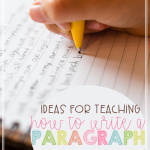
Many students struggle to put together one paragraph, let alone the multi-paragraph essays that common core requires them to do. Since they often lack the ability to put together a paragraph, writing often becomes a chore and they lack the motivation to do any form of writing. So just how do we get out of this writing rut so that students can become engaged and learn to write a paragraph (and eventually the required multi-paragraphs)?
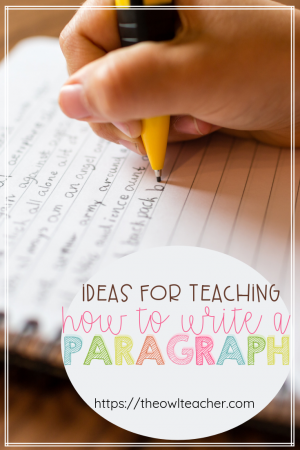
Ideas to Teach Writing a Paragraph
Start with the basics. When teaching students about paragraphs, we talk about the hard and fast rules, such as indenting, having approximately 3-5 sentences, and the structure of it. While I know paragraphs are not set in stone at 3-5 sentences, nor do they always have a main idea as the topic sentence, I like to give my students structure for the foundations and then as they progress expand a bit more with the “hard and fast” rules.
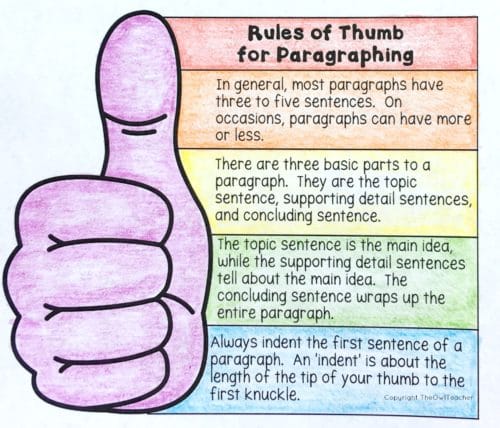
The Parts of a Paragraph. After we discuss the general “rules” of paragraphing, I then provide my students with sample paragraphs to analyze for the basic structure. We go through paragraphs and highlight the topic sentence, the supporting details, and the concluding sentence. I want students to start noticing that paragraphs always have a main idea and supporting details. Not only is this important for writing, but it helps them when it comes to reading. When you pull out highlighters, students are instantly engaged !
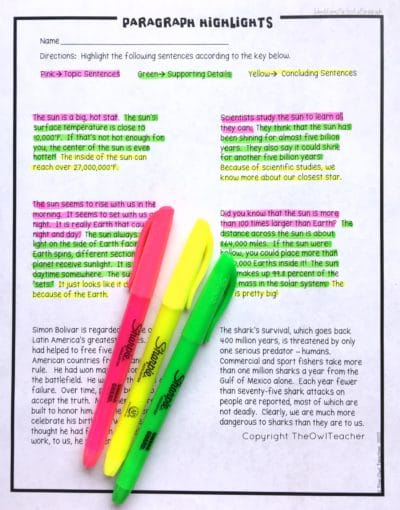
Sorting Strips Once students have gotten down to the basic structure of paragraphs, then I provide students with a paragraph that has been cut up into sentence strips. Each sentence of the paragraph is on its own strip and students have to determine which strip is likely the topic sentence, the concluding sentence, and supporting details. They also place the strips in order. This helps students take note of the characteristics of each type of sentence. For instance, a student is more likely to notice that a main idea sentence will sound very different from a supporting detail or a concluding sentence. This also helps them practice the flow of a paragraph.

Turning Lists into Paragraphs Once students really have the foundations of a basic paragraph down, I then start focusing on each individual piece. For instance, I might provide students with many supporting details and have them try to come up with a topic sentence. I may also provide students with a list of topic sentences and they have to brainstorm a list of supporting details. Another idea is to provide students with an object and have them make a list of ways it can be used. Then I work with my students to turn these lists into a paragraph.
Check out these related products
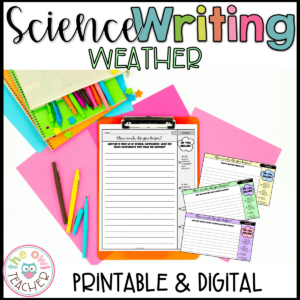
Writing Frames Another option I remember learning while attending an Anita Archer conference (and is very successful for emergent writers) is using writing frames. In this case, the basic premise of a paragraph is set up for a student and they fill in the examples. See below.
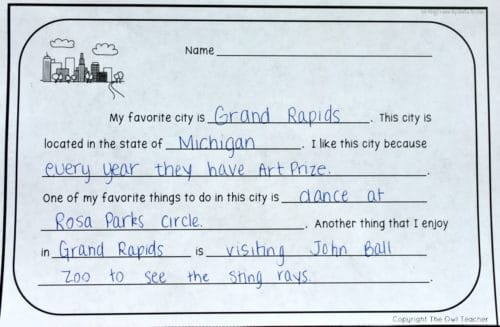
Guided Writing After we have experimented a bit with creating topic sentences and supporting details, then I guide my students into writing their own paragraphs off the top of their heads. I walk them through each part step-by-step. We usually create a booklet together to make it motivating.
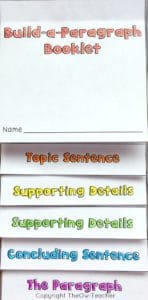
Final Writing with Graphic Organizers Once we have worked together through these steps of scaffolding , I then provide students with a graphic organizer and let them loose to create their own paragraph independently . I try to make it engaging by having them create their own Paragraph Sandwich. My students really enjoy this activity and they turn out really great!
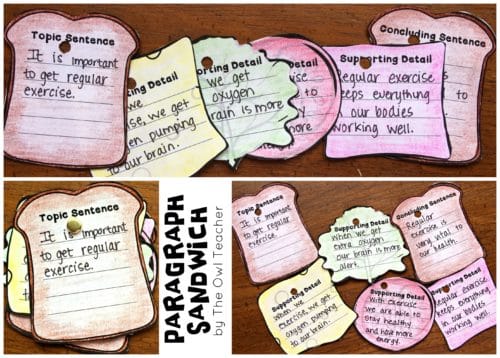
Hopefully, you can find some of these ideas useful in teaching your students about writing paragraphs. After students have the basic structure of writing paragraphs down, then you can begin moving into stretching those paragraphs with elaboration and much more!
Looking for a quick and easy way to implement these activities? You can find them (plus more!) in my store for an inexpensive price!

FIND IT NOW!
Check me out on tpt.

CHECK THESE OUT

Three Types of Rocks and Minerals with Rock Cycle Circle Book

Partitioning Shapes Equal Share Fractions Halves, Thirds, Fourths Math Puzzles
Want to save time?
COPYRIGHT © 2016-2024. The Owl Teacher | Privacy page | Disclosure Page | Shipping | Returns/Refunds
BOGO on EVERYTHING!
- INSTANT DOWNLOADS
- HANDWRITING
- FUN WITH FOOD
- -- BACK TO SCHOOL
- -- HALLOWEEEN
- -- VETERAN'S DAY
- -- THANKSGIVING
- -- CHRISTMAS
- -- NEW YEARS
- -- PRESIDENT'S DAY
- -- CHINESE NEW YEAR
- -- VALENTINE'S DAY
- -- EARTH DAY
- -- ST. PATRICK'S DAY
- -- MOTHER'S DAY
- -- END OF SCHOOL YEAR
- -- FLAG DAY
- -- FATHER'S DAY
- -- FOURTH OF JULY
- ENCOURAGEMENT
- TRANSFORM YOUR TEACHING
FUN Ways to Teach Letter Writing


- Latest News
- The Week in Education
- School Announcements
- How We Did It
- Spotlight on a School
- 30 minutes with…
- Heads & Governors
- Admissions & Marketing
- Bursars & Finance
- HR & Staff Recruitment
- Development & Fundraising
- Alumni Relations
- Communications & PR
- Wellbeing & Inclusion
- Education Technology
- Estate Management
- Data Management
- Safeguarding
- Online Learning
- Exams & Assessment
- Diversity and Inclusion
- Sports and Outdoors
- International School News
- The View From Here
- School Owners & Operators
- Curriculum Design
- Overseas Development
- International School Magazine
- CEO & Trust Leadership
- Partnerships
- Social Mobility
- Government Policy
- Special Measures
- View Vacancies
- Movers & Shakers
- Why work here?
- Inspiring Leadership
- Russell Speirs & Friends
- Get Started with AI
- The Friday Club
- Sales Hacks for Schools
- Talking Recruitment
- Membership Bodies
- School Leaders Talk
- Supplier Reviews
- From Our Partners
- Supplier Directory
- Advertise with us
- Editorial Board
- Independent School Management Plus
- Distribution Partners

Use AI text-to-image generators to teach creative writing
In his most entertaining episode yet, darren coxon uses adobe firefly as a fun way to teach creative writing.

A writer’s job is to transfer what is in their head into the heads of their readers. The best writers do this concretely and effectively.
We can use AI to replace the reader’s mind to teach students how to write vividly. This simple exercise powerfully shows how. By starting with a vague description and gradually fleshing it out, we move from what is in our mind to what is shown on the screen drawing closer together.
I like using Adobe Firefly for this exercise as it’s safe and creates excellent images. Remember that those under 13 shouldn’t have direct access – the teacher needs to do the inputting.
- For this exercise, you begin with the simplest sentence you can think of, such as ‘Create an image of a dog.’ Pupils then have to guess what the dog might look like.
- From here, you go step by step, adding detail. Every time more detail is added, pupils can better ‘picture’ the image before it is generated. Add adjectives, verbs, adverbs, prepositions, etc. Sometimes, it will give you a weird image – this will likely be due to you adding image elements that would not usually be seen together. This is a good teaching point – image generators are trained on existing data, so will make a best guess if they’ve not seen particular elements together before.
- Under supervision, pupils can create their own highly detailed and concrete paragraphs and introduce them to the text-to-image AI, which will visually represent their writing. Fun examples of descriptive paragraphs can include:
- Create your own children’s storybook character
- Create your version of the BFG
- Create a classroom of the future
- Create images of a sustainable city
- Design a room in Santa’s toy factory
Here is one prompt example:
“Create a 3D image of an adorable woodland creature with soft, mossy skin that resembles tree bark, unlike its gruff relatives. Short, leafy branches sprout playfully from its shoulders. Large, warm yellow eyes glow brightly, reminiscent of fireflies nestled in amber. Its oversized feet have stubby toes that resemble cheerful little roots. A wide, friendly grin spreads across its face, revealing small, smooth pebbles for teeth. This gentle creature casts a playful, dappled shadow on the forest floor bathed in warm sunlight.”
You can find many more free ideas I created in Study Hall’s Prompt Hub: studyhall.ai/schools . Sign up with your school email address. International schools must be whitelisted, so contact Study Hall via their website.
Darren Coxon
Darren Coxon is the founder of Coxon AI. He was previously chief operating officer at the Britus Education group of international schools. Prior to that he was director of education at Forfar Education, among other positions in education. He is a former English teacher.

Sales Hacks for Schools: Pick up the phone

Talking Recruitment: Improving the job application process

How to use AI to create school policy documents

Average school fees rise by 8 per cent

AI in Education: ‘This is a pivotal moment’

30 minutes with…Ann Haydon MBE, Harrow International Hong Kong

Abingdon School to admit girls for the first time

© 2020 Independent School Management Plus.
Navigate Site
- UK Independent
- International
Welcome Back!
Login to your account below
Remember Me
Retrieve your password
Please enter your username or email address to reset your password.
Add New Playlist
- Select Visibility - Public Private

Home » Tips for Teachers » Here is Your Ultimate Guide to 7 Creative and Fun Ways How to Teach Grammar Through Writing!
Here is Your Ultimate Guide to 7 Creative and Fun Ways How to Teach Grammar Through Writing!
If you’re a teacher, chances are you already have an idea of how difficult teaching grammar can be. Many students and teachers are insistent that traditional methods of practicing grammar are not effective. One creative and fun way to teach grammar that is known to produce great results is to teach grammar through writing.

From my years of experience teaching writing, I can tell you that writing and grammar go hand in hand. Students are much more likely to retain information about grammar when it’s learned in context, rather than from a worksheet. If students learn about the natural flow of grammar as well as specific grammar concepts from writing and reading, it will be very beneficial to their long-term grammar knowledge.
Because grammar is a difficult and debated topic in teaching, often teachers have to get a little creative when planning lessons for their students. If you don’t know where to start with teaching grammar, don’t fret! Here is your ultimate guide to teaching grammar through writing. After reading this article, you will know all about:
- Why Teaching Grammar is So Important→
- Different Methods You Can Use to Teach Grammar→
- How to Teach Grammar Through Writing→
- Activities to Help You Use Writing to Teach Grammar→
Once you know about all the ways you can incorporate grammar into your writing lessons, you will have all the tools you need to build fun and effective lessons for your students!
Why is it Important to Teach Grammar Correctly?
One of the reasons teaching grammar is such a difficult area is because it’s extremely important that it’s done correctly. If students aren’t taught the building blocks of grammar, their writing and future linguistic progress will suffer. Unfortunately, many students over the years have been taught grammar incorrectly from disengaged, uninformed teachers.
According to the 2014 English National Curriculum, “Explicit knowledge of grammar is very important, as it gives us more conscious control and choice in our language.” Students who do not have a proper grasp of grammar may struggle with control over language in their writing. However, grammar is also a subject that many students historically dislike and are resistant to learn.
Stubborn as some students may be, incorporating grammar into lessons is crucial for students’ future success. Grammar also plays a huge role in improving students’ speech. If you work on teaching grammar through writing and reading with your students, chances are you’ll notice the grammar in their speech improving too.
If you want to know a little more about common challenges teachers face while teaching grammar, check out this YouTube video!
If you’re teaching online, a camera is an essential piece of equipment for a grammar lesson.
Four Different Methods of Teaching Grammar
Before we get into our ultimate guide on teaching grammar through writing, let’s take a look at some of the different methods of teaching grammar that are out there. By having an idea of the different ways how to teach grammar, you can decide what method would work best for you and your students!
1. The Traditional Method
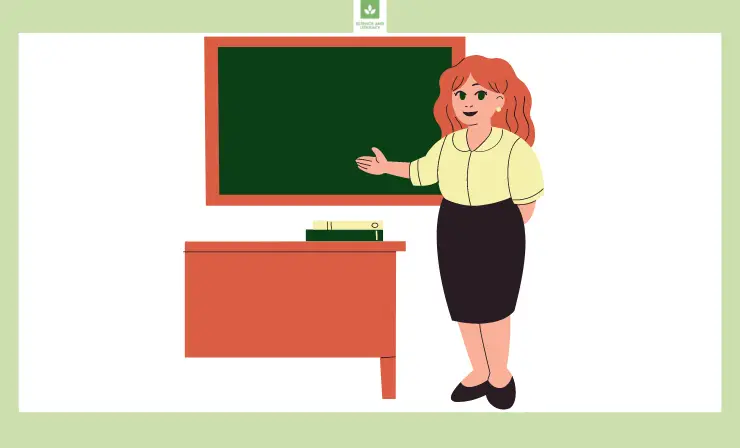
The first method of teaching grammar we’ll be talking about today is the traditional method. For decades and even centuries, teachers have been using this method to impart grammar knowledge upon their students. Many aspects of the traditional method are still being used in schools, though most classrooms today aim to use traditional grammar exercises as supplementary learning in combination with more progressive methods.
In traditional grammar lessons, the main tools of the trade are lists, worksheets, and grammar textbooks. Traditional teaching methods utilize “memorization-based techniques that [rely] on repetition.” While this more traditional method of teaching grammar is still used in classrooms sometimes, particularly where students are learning English as a second language, more creative and interactive methods of teaching grammar are generally favored today.
2. The Model Method

One very popular way of teaching grammar outside of the traditional method is the model method. The model method, or teaching by modeling, involves showing students ‘models’ of good writing and grammar that they can observe and mimic. For students who are native English speakers, it does much more for retention to see grammar properly used within context than to simply complete a worksheet or grammar exercise.
To teach using the model method, provide your students with short stories and novels to read and tell them to look up to the authors as grammar mentors. As your students read throughout the year, either independently or as a class, they will get a sense for the way grammar works in context. If you have been working on any specific grammar concepts with your class, have them write down examples they notice from their reading in a notebook, which you can then go over in class. Of course, sometimes authors break grammar conventions for artistic purposes, so if that crops up it’s a good opportunity to teach your class about where and when grammar rules can be broken.
3. Teaching in Context
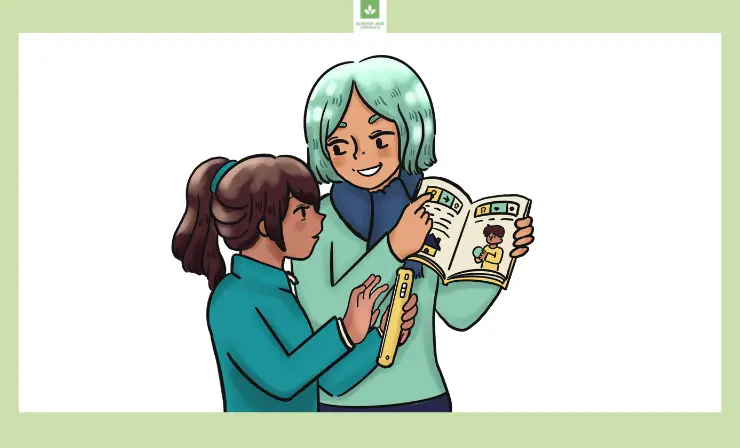
For students who are too young to read texts for the model method, teachers can get a similar effect by teaching in context. Teaching in context involves showing students short examples, either verbal or written, to illustrate grammar concepts. Ideally, teachers should want these examples to tell a story and be interesting and engaging for students. This one is a creative spin on traditional grammar exercises, allowing students to learn through fun paragraphs and stories as opposed to exercises that many students find boring.
4. Selective Grammar Review
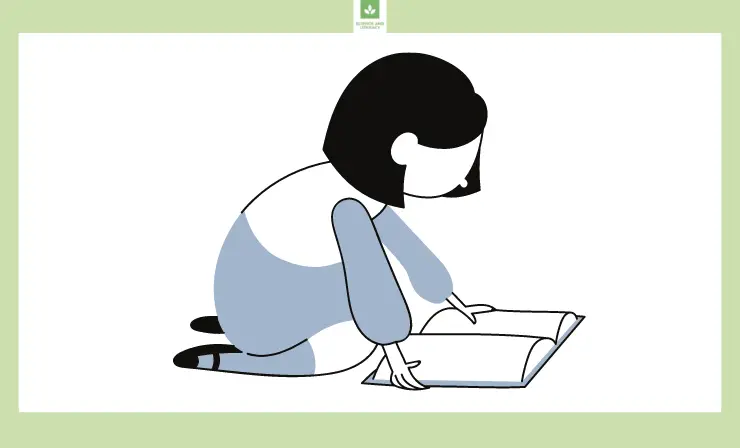
Another method of teaching grammar that is increasingly common in classrooms is selective grammar review. Especially with younger students, there are often too many grammar concepts to go over in one school year. For students who are native English speakers, it is more important to make sure they have a general feel for the way grammar works through spoken and written speech, then address grammar terminology later.
According to literacy specialists, teachers find that they have to “temporarily ignore certain mistakes in order to intentionally focus on a single teaching point.” This means that rather than trying to tackle every little grammar mistake your students make in their writing and speech, you should choose specific concepts to focus on that are both age-appropriate and related to their demonstrated grammar struggles.
Some teachers like to incorporate document cameras into their grammar lessons.
Also, my colleagues have made a podcast about teaching Grammar. You can listen to it following the link below.
How to teach grammar through reading and writing workshop. https://t.co/01o3GHUMbh — Ashley Hubner, M. Ed. (@ashley_hubner) July 20, 2018


The One Method That Changes Your—and All Students’—Writing
Science-based writing methods can achieve dramatic results..
Posted May 14, 2024 | Reviewed by Abigail Fagan
- Why Education Is Important
- Find a Child Therapist
- A systematic writing framework offers a method for dramatically improving the teaching of writing.
- This method received only limited uptake, despite high-profile research publications and textbooks.
- A focus on writing style might have limited the method's impacts.

I remember spending hours commenting painstakingly on my students’ papers when I was a graduate student teaching in the Expository Writing Program at New York University. My students loved our classes, and they filled my sections and gave me terrific course evaluations. Yet I could see that their writing failed to change significantly over the course of the semester. I ended up feeling as if I should refund their money, haunted by the blunt instruments we had to teach writing.
As I’ve learned from directing five writing programs at three different universities, methods matter. When I reviewed comments on papers from instructors who taught in my programs, I discovered that the quantity and quality of comments on students’ papers made only a slight impact on writing outcomes. For instance, one notoriously lazy instructor took several weeks to return assignments and only used spelling and grammar checkers to automate comments. But his conscientious colleague made dozens of sharp observations about students’ arguments, paragraphs, and sentences. However, Mr. Conscientious’ students improved perhaps only 10% over Mr. Minimalist’s students. Even then, the differences stemmed from basic guidelines Mr. Conscientious insisted his students write to, which included providing context sentences at the outset of their essay introductions.
Educators have also poured resources into teaching writing, with increasing numbers of hours dedicated to teaching writing across primary, secondary, and higher education . Yet studies continue to find writing skills inadequate . In higher education, most universities require at least a year of writing-intensive courses, with many universities also requiring writing across the curriculum or writing in the disciplines to help preserve students’ writing skills. However, writing outcomes have remained mostly unchanged .
While pursuing my doctorate, I dedicated my research to figuring out how writing worked. As a graduate student also teaching part-time, I was an early convert to process writing. I also taught those ancient principles of logos, ethos, and pathos, as well as grammar and punctuation. Nevertheless, these frameworks only created a canvas for students’ writing. What was missing: how writers should handle words, sentence structure, and relationships between sentences.
Yet researchers published the beginnings of a science-based writing method over 30 years ago. George Gopen, Gregory Colomb, and Joseph Williams created a framework for identifying how to maximize the clarity, coherence, and continuity of writing. In particular, Gopen and Swan (1990) created a methodology for making scientific writing readable . This work should have been a revelation to anyone teaching in or directing a writing program. But, weirdly, comparatively few writing programs or faculty embraced this work, despite Williams, Colomb, and Gopen publishing both research and textbooks outlining the method and process.
Peculiarly, this framework—represented by Williams’ Style series of textbooks and Gopen’s reader expectation approach—failed to become standard in writing courses, likely because of two limitations. First, both Gopen and Williams hewed to a relativistic stance on writing methods, noting that rule-flouting often creates a memorable style. This stance created a raft of often-contradictory principles for writing. For example, Williams demonstrated that beginning sentences with There is or There are openings hijacked the clarity of sentences, then argued writers should use There is or There are to shunt important content into sentence emphasis positions, where readers recall content best. Second, these researchers failed to tie this writing framework to the wealth of data in psycholinguistics, cognitive neuroscience , or cognitive psychology on how our reading brains process written English. For instance, textbooks written by these three principal researchers avoid any mention of why emphasis positions exist at the ends of sentences and paragraphs—despite the concept clearly originating in the recency effect. This limitation may stem from the humanities’ long-held antipathy to the idea that writing is a product, rather than a process. Or even that science-based methods can help teachers and programs measure the effectiveness of writing, one reason why university First-Year Writing programs have failed to improve students’ writing in any measurable way.
Nevertheless, when you teach students how our reading brains work, you create a powerful method for rapidly improving their writing—in any course that requires writing and at all levels of education. Students can grasp how writing works as a system and assess the costs and benefits of decisions writers face, even as they choose their first words. This method also works powerfully to help students immediately understand how, for instance, paragraph heads leverage priming effects to shape readers’ understanding of paragraph content.
Using this method, I and my colleagues have helped students use a single writing assignment to secure hundreds of jobs, win millions in grant funding, and advance through the ranks in academia. However, we’ve also used the same method without modifications in elementary and secondary classrooms to bolster students’ writing by as much as three grade levels in a single year.
Perhaps the time has arrived for this well-kept secret to revolutionizing student writing outcomes to begin making inroads into more writing classrooms.
Gopen, G. D. and J. A. Swan (1990). "The Science of Scientific Writing." American Scientist 78(6): 550-558.
Gopen, George. The Sense of Structure: Writing from the Reader’s Perspective . Pearson, 2004.
Gopen, George. Expectations: Teaching Writing from the Reader’s Perspective . Pearson, 2004.
Williams, Joseph. Style: Toward Clarity and Grace . University of Chicago Press, 1995.
Williams, Joseph. Style: Ten Lessons in Clarity and Grace . Harper Collins, 1994.
Williams, Joseph. Style: The Basics of Clarity and Grace . Longman, 2002.

Jane Yellowlees Douglas, Ph.D. , is a consultant on writing and organizations. She is also the author, with Maria B. Grant, MD, of The Biomedical Writer: What You Need to Succeed in Academic Medicine .
- Find a Therapist
- Find a Treatment Center
- Find a Psychiatrist
- Find a Support Group
- Find Online Therapy
- United States
- Brooklyn, NY
- Chicago, IL
- Houston, TX
- Los Angeles, CA
- New York, NY
- Portland, OR
- San Diego, CA
- San Francisco, CA
- Seattle, WA
- Washington, DC
- Asperger's
- Bipolar Disorder
- Chronic Pain
- Eating Disorders
- Passive Aggression
- Personality
- Goal Setting
- Positive Psychology
- Stopping Smoking
- Low Sexual Desire
- Relationships
- Child Development
- Self Tests NEW
- Therapy Center
- Diagnosis Dictionary
- Types of Therapy

At any moment, someone’s aggravating behavior or our own bad luck can set us off on an emotional spiral that threatens to derail our entire day. Here’s how we can face our triggers with less reactivity so that we can get on with our lives.
- Emotional Intelligence
- Gaslighting
- Affective Forecasting
- Neuroscience

VIDEO
COMMENTS
1. Creative writing fosters creativity and imagination. It encourages you to think outside the box, broaden your perspective, and explore new ideas. It also enhances your ability to communicate effectively, as it involves conveying thoughts, emotions, and narratives in a clear and compelling manner. 2.
Creative writing should be fun, and playing games is good way to help students develop story ideas. Try an alternative word association game in which you think of words that are at odds with each ...
Here are 10 of our favorite story telling activities that inspire students: 1. Write an "I am from" poem. Students read the poem "I am From" by George Ella Lyon. Then, they draft a poem about their own identity in the same format Lyon used. Finally, students create a video to publish their poems.
The development of writing skills is an integral part of language instruction. As a result, some students only associate writing with school. Shifting the focus away from academics can help your class learn to enjoy writing for the sake of writing. Turning writing into a fun activity not only reduces anxiety over grades, but also encourages students to develop a more positive relationship with ...
3. Avoid teaching a story "formula.". One of the most important things to remember when teaching creative writing is to dispense with the idea that stories should follow certain arcs or formulas. While formulaic writing can aid students who need direction, it can also bind students and limit their imaginations.
We've outlined a seven-step method that will scaffold your students through each phase of the creative process from idea generation through to final edits. 7. Create inspiring and original prompts. Use the following formats to generate prompts that get students inspired: personal memories ("Write about a person who taught you an important ...
What a fantastic way to teach them how to use these essential creative writing tools! Learn More: Teacher By The Beach. 45. Sensory Poetry. Another great way to teach sensory details is to have your learners write poems about their favorite foods! Task them with writing a line for each sense to describe the food!
Give your pupils freedom. Use story-starters and prompts. Elaborate with a story generator. Get the children to take creative writing home. 1. Use a workshop-style environment. Separate your class into groups or tables, each group will then be able to choose what they work on.
2. RELEVANT WRITING. Picture this. Energetic lyrics fill the air as students listen, think critically, and analyze them. Or, students snap a photo of a page from an independent reading book, grinning as they annotate it with gifs, text, emojis, and more. Spotify and Snapchat are extremely popular apps for students.
7. Comic Strip Script. The Purpose: Give your students the chance to improve their dialogue writing skills and work on their understanding of character development in this fun activity which combines writing with a series of visual elements. The Process: There are two ways to do this activity.
It's fast and fun. Students love reading and adding to each other's stories. Students are practicing spontaneous writing - their imaginations are firing and their creative writing skills are being challenged. Reinforces writing skills - students know their story needs to have a beginning, middle, and end.
6 Ways to Teach Writing reatively Teach your students the fun aspects of writing. Students of all ages write short stories and papers, from younger elementary-school writers through college-age students.
Activity #3 : Writing Center Posters and Paper. If you do not have a writing center, I highly recommend you create one. It does not have to be a large area that takes up a lot of wall space. My writing center gives me another outlet to foster my students' creativity by way of writing.
Dive into a spooky-type short story and character analysiswith "The Most Dangerous Game.". "Most Dangerous Game" Character Analysis Workbookfrom Teach BeTween the Lines. MAKER SPACE. This creative lesson to inspire secondary writers is a newer approach. Turn your writer's workshop into a maker spacewith these unique ideas from Spark ...
Here are the few ways how high schoolers can benefit from creative writing -. 1. Imagination. When you write creatively, you expand your imagination by creating new environments, scenarios, and characters. This way, you are also boosting and stretching your imagination, as well as "thinking out of the box.".
3. Script it Out! This one actually works well as an extension for the character sketch, if your student enjoys storytelling or theater. It's also a fun way to dig into script writing! The script can be for a short play, a YouTube sketch, or a skit for a club or group. Let your child be creative! 4. Pick a Character.
The purpose of creative writing exercises is to expand your imagination and to spark new ideas or thoughts, encouraging you to practice writing these before you start on your next project. Themed writing prompts can be helpful here, breaking down your prompts into different buckets like: Food. Animals. Landscapes.
Select a Narrative Sentence Starter Card, and display or write it on the whiteboard. Ask your students to think of an imaginative way to finish the sentence, (the sillier the better). Provide your students with a little thinking time. Ask each student to share their response when you call their name.
If you're interested in the world of creative writing, we have eight fantastic exercises and activities to get you started. ️🤩 Don't miss on the joy of Creative Writing: here are 8 ways to get started. Click to tweet! 1. Use writing prompts every week. Coming up with ideas for short stories can be challenging, which is why we created a ...
Here are five fun ways to teach the writing process to even the most stubborn students. #1: Play-Doh Creations. ... "This activity encourages students to see writing as a communicative and creative task where there needn't be a 'right' answer," Literacy Ideas says. "This encourages students to be more willing to take on creative ...
Ideas to Teach Writing a Paragraph. Start with the basics. When teaching students about paragraphs, we talk about the hard and fast rules, such as indenting, having approximately 3-5 sentences, and the structure of it. While I know paragraphs are not set in stone at 3-5 sentences, nor do they always have a main idea as the topic sentence, I ...
First, discuss the basic parts of the letter. Using this printable to introduce the basic format of a letter is a creative way to tie in the relationship of the head and body. This is a cute song to help learn the parts of a letter. Here are several free powerpoints that teach letter writing.
In his most entertaining episode yet, Darren Coxon uses Adobe Firefly as a fun way to teach creative writing. by Darren Coxon. May 15, 2024. in EdTech, Get Started with AI, International Schools, Multi-Academy Trusts, News, Teaching & Learning. Reading Time: 2 mins read 1 0. A A. A A.
This one is a creative spin on traditional grammar exercises, allowing students to learn through fun paragraphs and stories as opposed to exercises that many students find boring. 4. Selective Grammar Review. Another method of teaching grammar that is increasingly common in classrooms is selective grammar review.
A systematic writing framework offers a method for dramatically improving the teaching of writing. This method received only limited uptake, despite high-profile research publications and ...